
Self-regenerating area
Self-regenerating area
We left several areas of the swamp untouched to observe and try to understand nature's strategies.
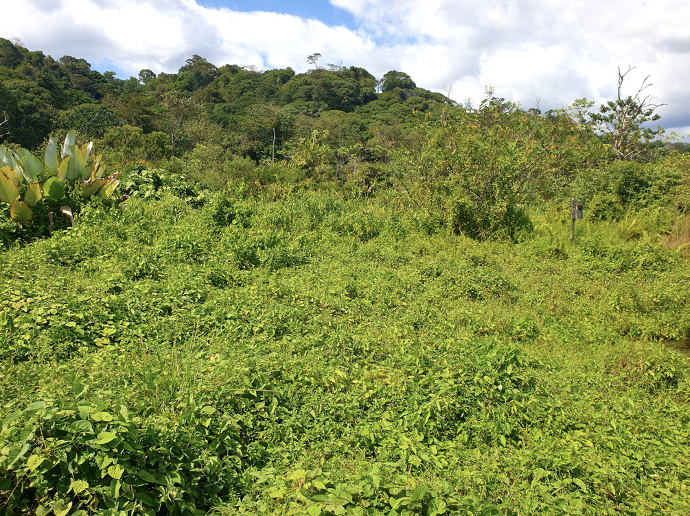
The first step in nature's recovery are so-called 'weeds'. They draw minerals from the depth of the soil and store them in their stems and leaves. When they die, they decompose and return the minerals to the topsoil where they eventually become available for more delicate plants and trees. In our cultivated areas we use this strategy to speed up the process of soil recovery: instead of uprooting weeds, we chop and drop them until the soil improves.
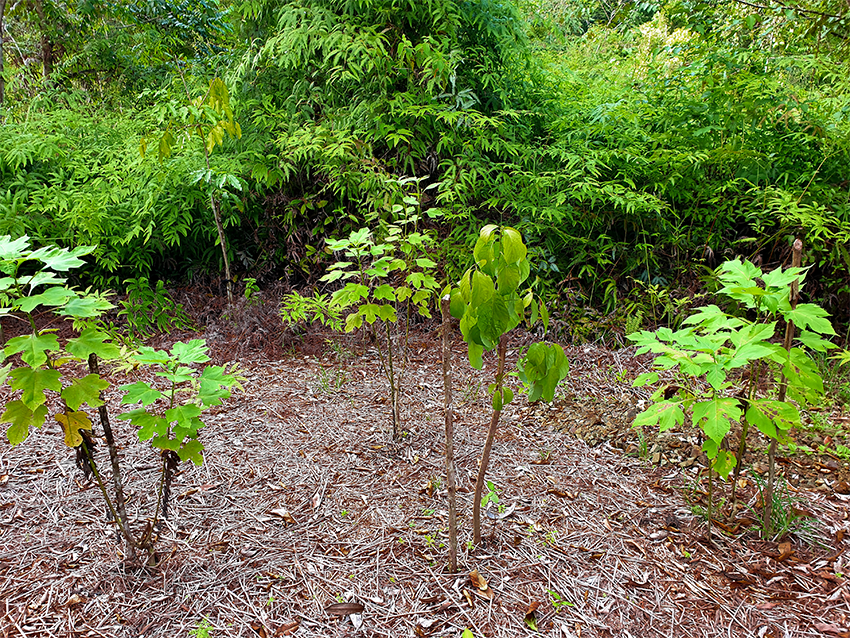
We then plant our trees into the resulting mulch and continue to chop and drop the weeds around them. It may take a bit longer, but the trees grow strong and when their canopy closes, the weeds have done their job and will be shaded out.

Sustainable architecture
Sustainable architecture
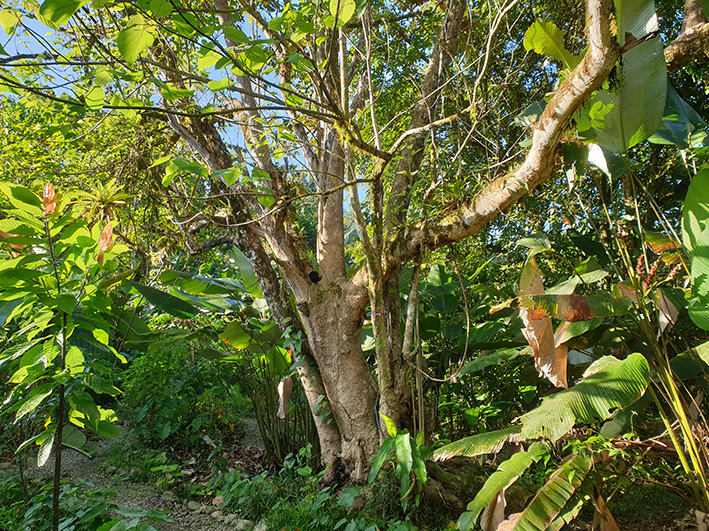
Decades ago, white teak (Gmelina arborea), an invasive tree from Asia, was introduced to Costa Rica with disastrous ecological consequences: their roots excrete chemicals that hamper the growth of native trees and their fruits are toxic for toucans, macaws and other animals.
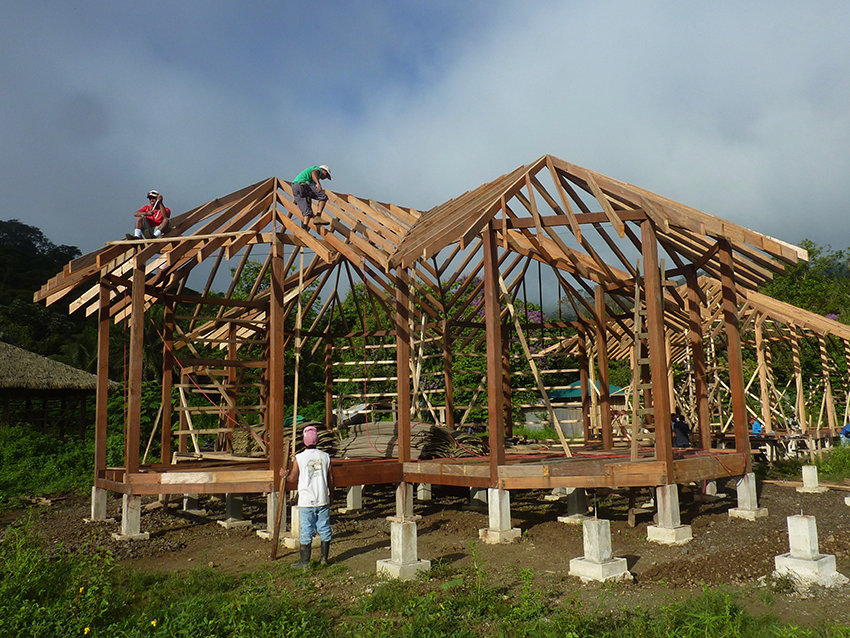
We felled these trees on our land and recycled the wood for the construction of our buildings.
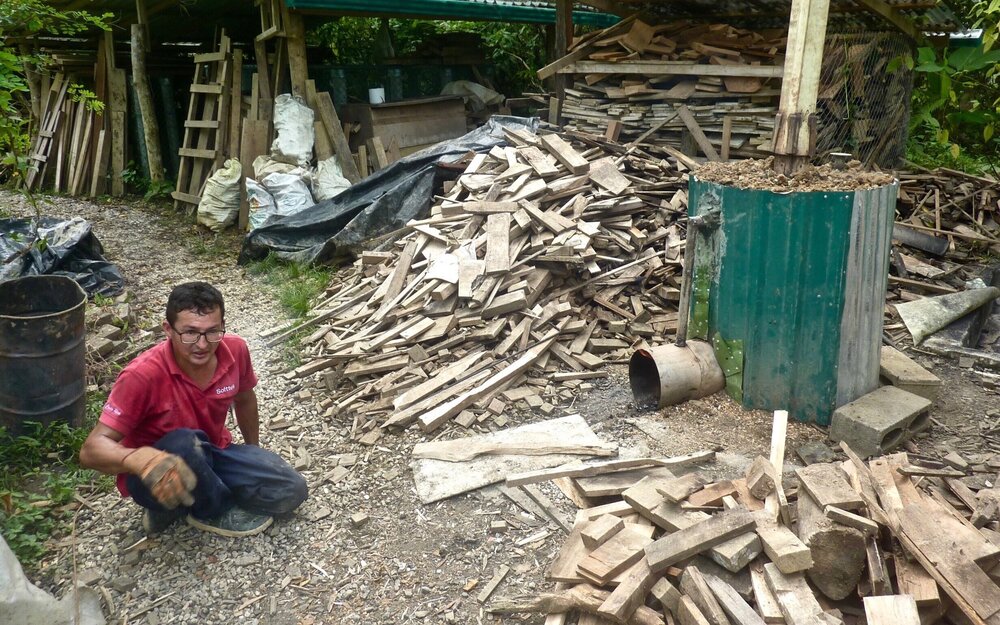
The rest wood we turned into biochar and returned it to our soils. We then reforested the area with a variety of native trees.
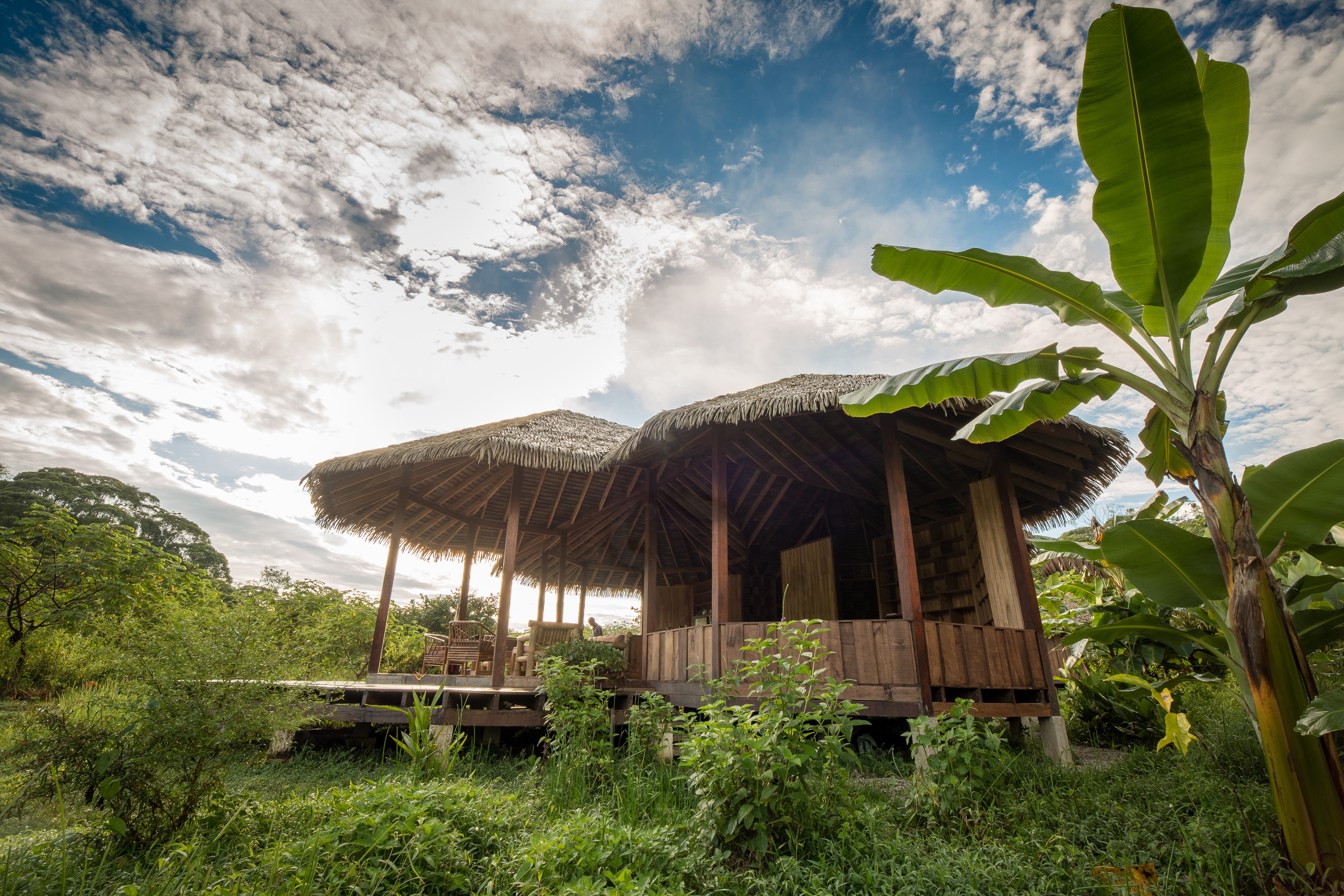
To protect the wildlife we abstain from electric lights. All buildings are designed by Alexander Tinti. Click here to explore how we use the Casa Grande, the Studio, the guest house, and the bungalows.

Wildlife ponds
Wildlife ponds
Since the Refugio is built on wetland, wildlife ponds play a crucial role in our landscaping. When we arrived, we were faced with a set of special challenges: how do we restore a toxic swamp to achieve maximum biodiversity and how do we reforest the area for the biological corridor without draining the land?
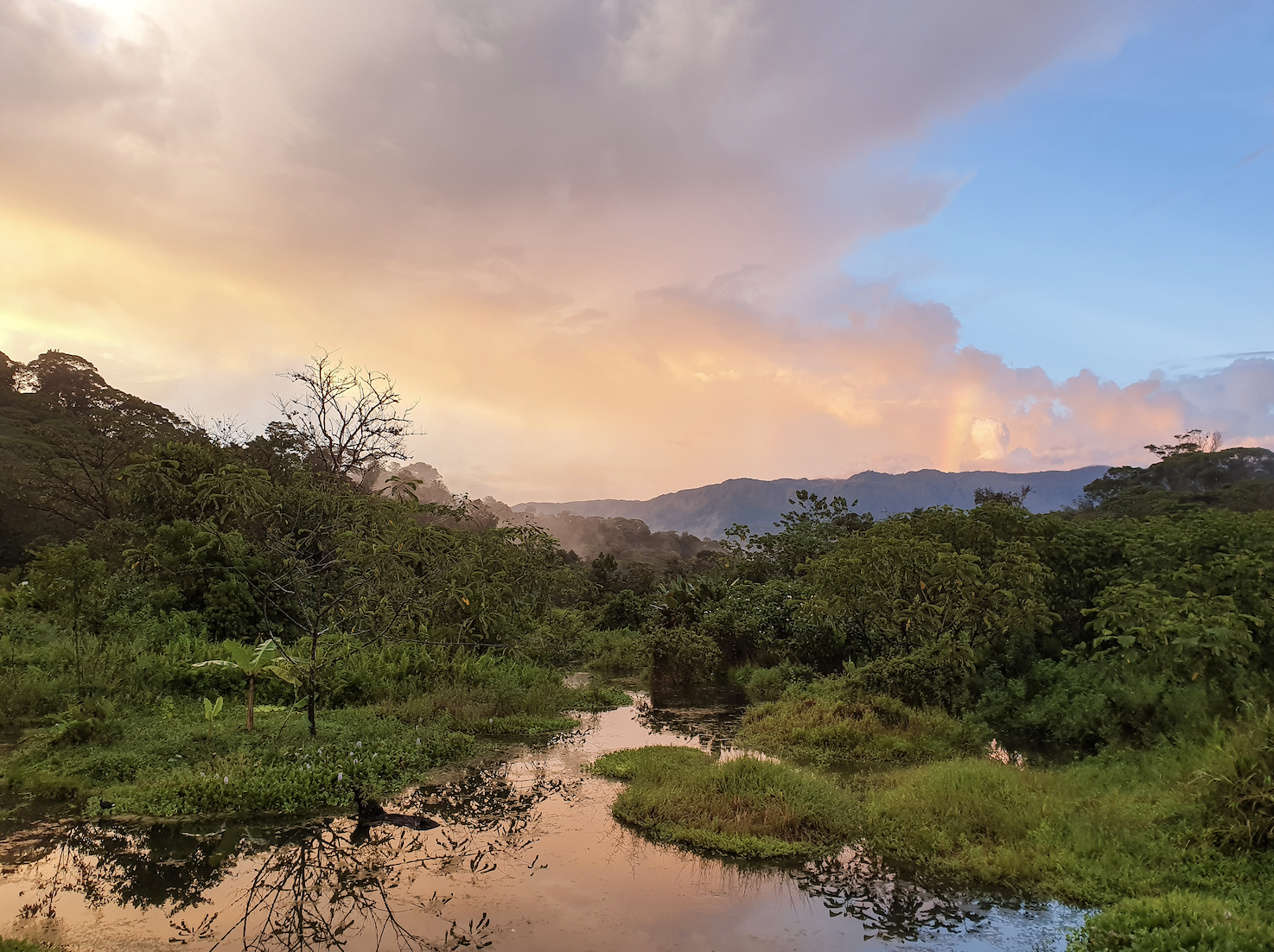
We opted for a series of shallow wildlife ponds and piled up the excavated earth between them. This resulted in areas just dry enough for a variety of special swamp trees, fit to survive in such wet conditions.
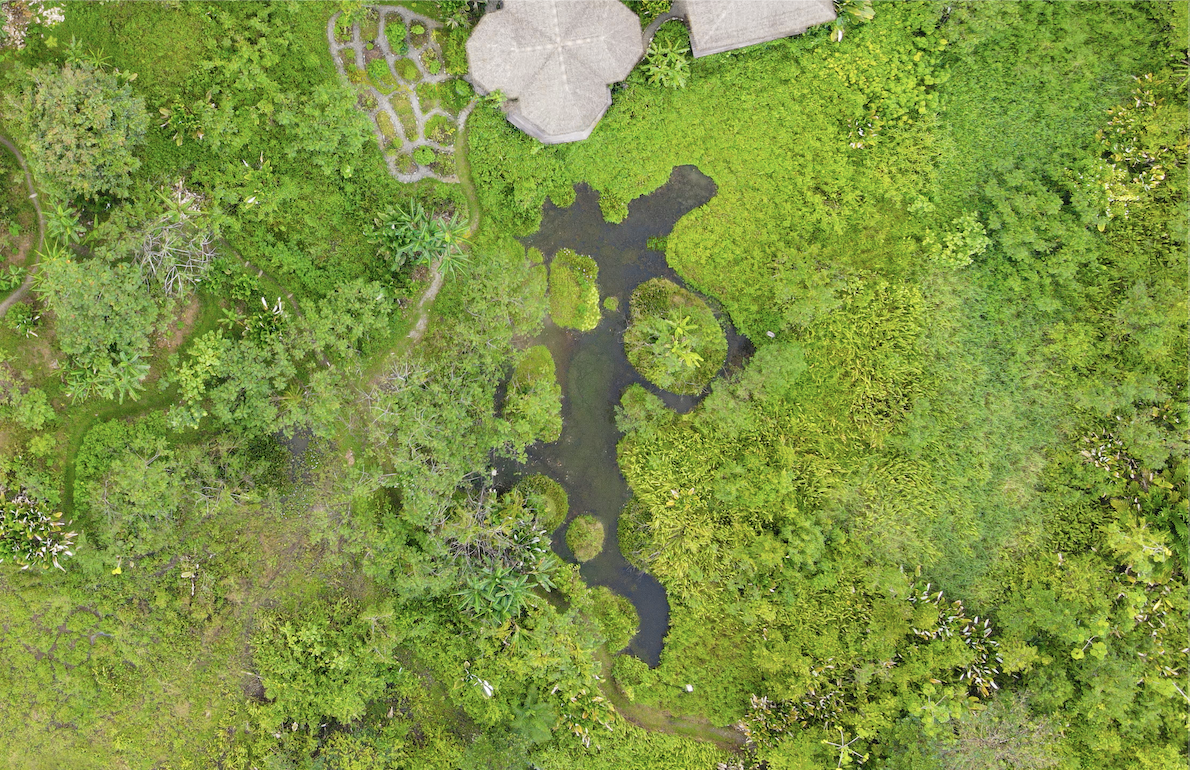
The highest biodiversity always develops at the transition from one element to the other, so our ponds are designed as irregularly as possible, extending their shorelines to a maximum length. Even under the water, hardly any flat surface is found.

Buffalos
Buffalos
The African water buffalo is a massive and impressive animal. If you spend time with them though you can establish a connection and they become very tame and affectionate.
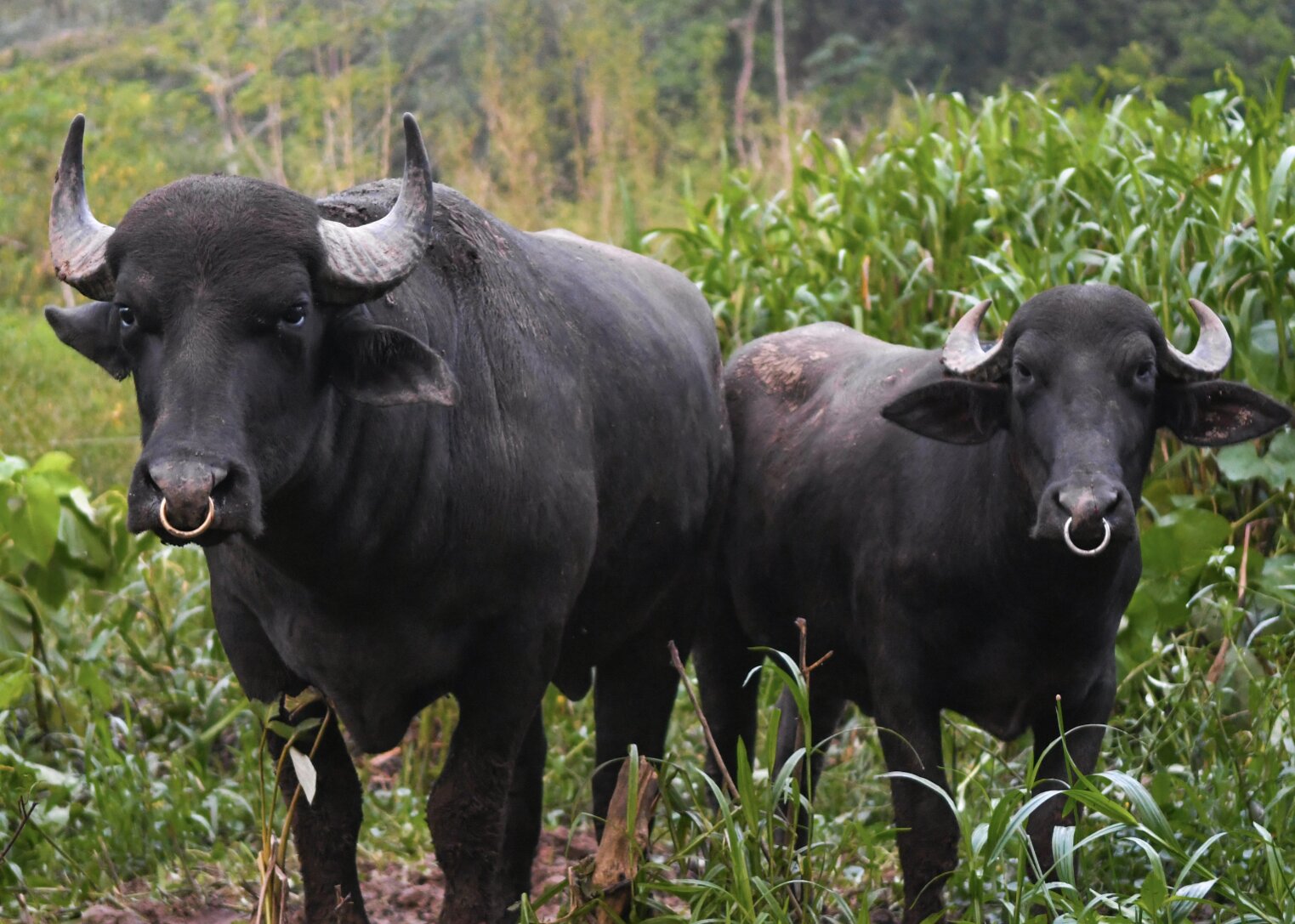
Apart from being lovely pets, their function in the system is the creation of new habitats. A large swath of the Refugio is a shallow lake that is choked with a stand of invasive reeds, so dense that little life is able to thrive there.
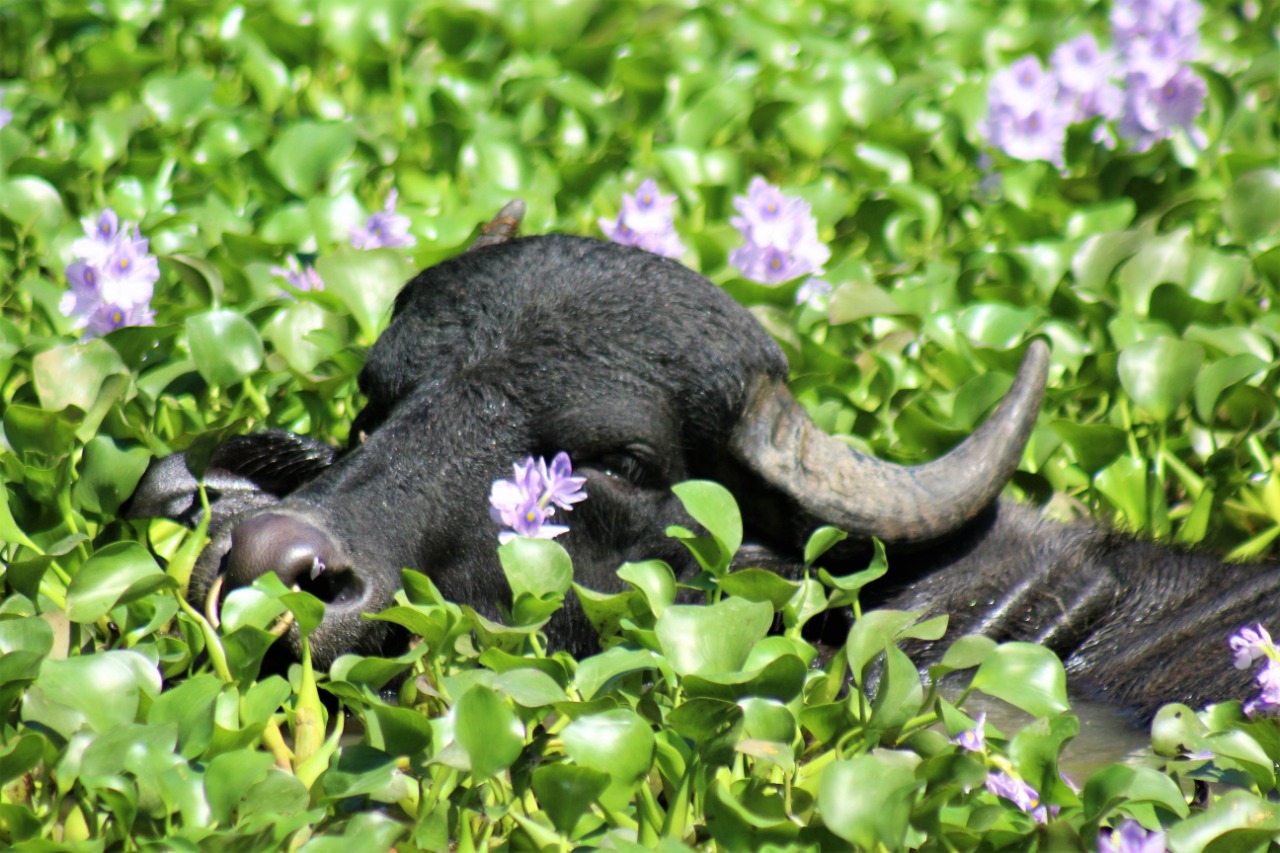
Through grazing and the creation of mud puddles to cool down and to fend off insects, they create micro-habitats for many animals, most notably several species of herons, white and green ibis, and many species of frogs and dragonflies.

Chicken
Chicken
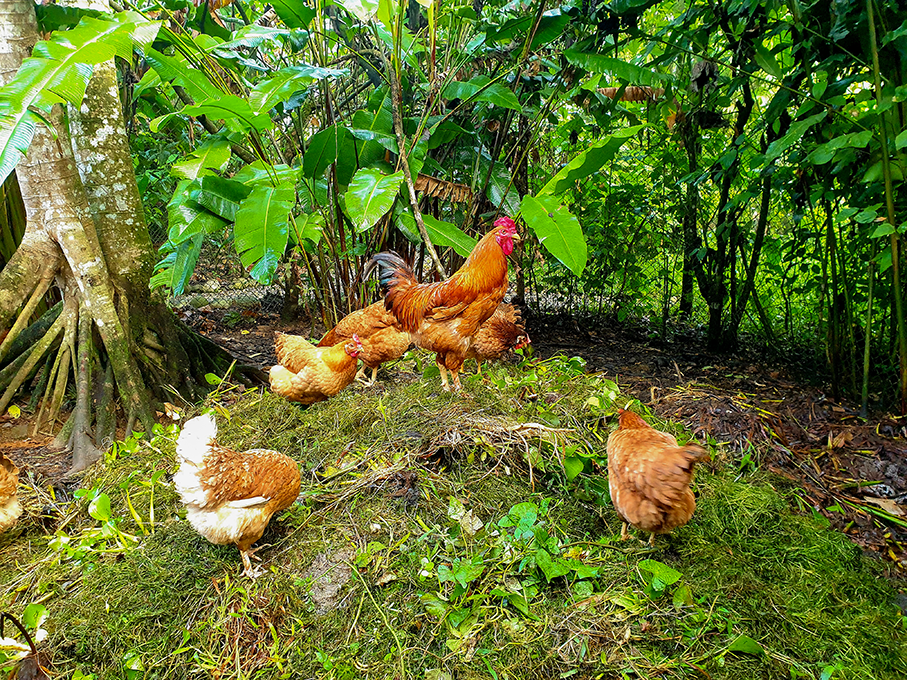
Chicken are an important multifunctional element in any permacultural system as they play an important role in closing cycles. They provide food (eggs), produce raw material for compost (chicken dung is especially high in nitrogen and phosphorus), and help with pest and weed control. Last but not least, they are a joy to be with.
Our chicken have all they need:
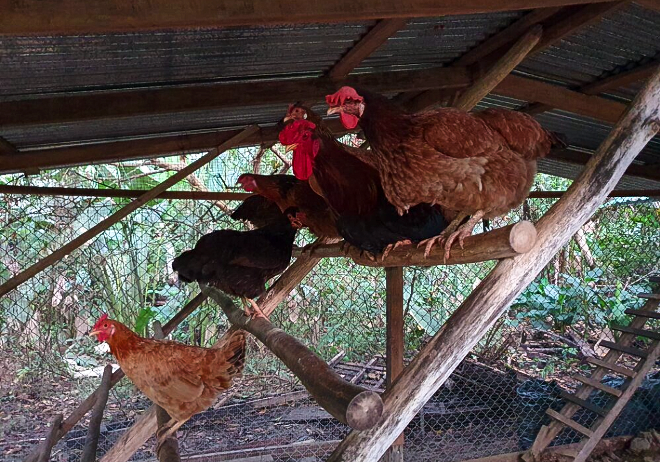
A safe enclosure for the night.
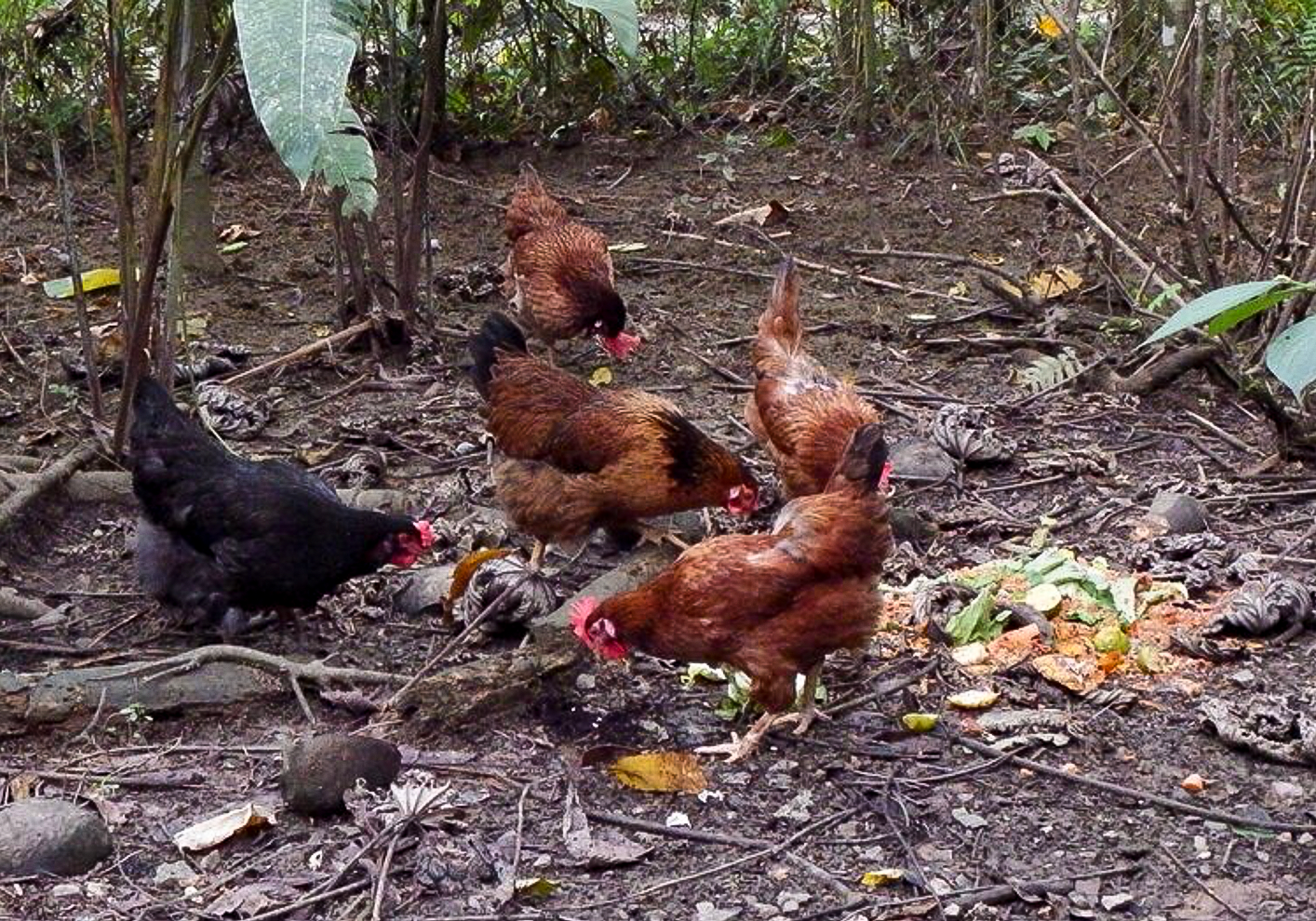
A large scratch territory.
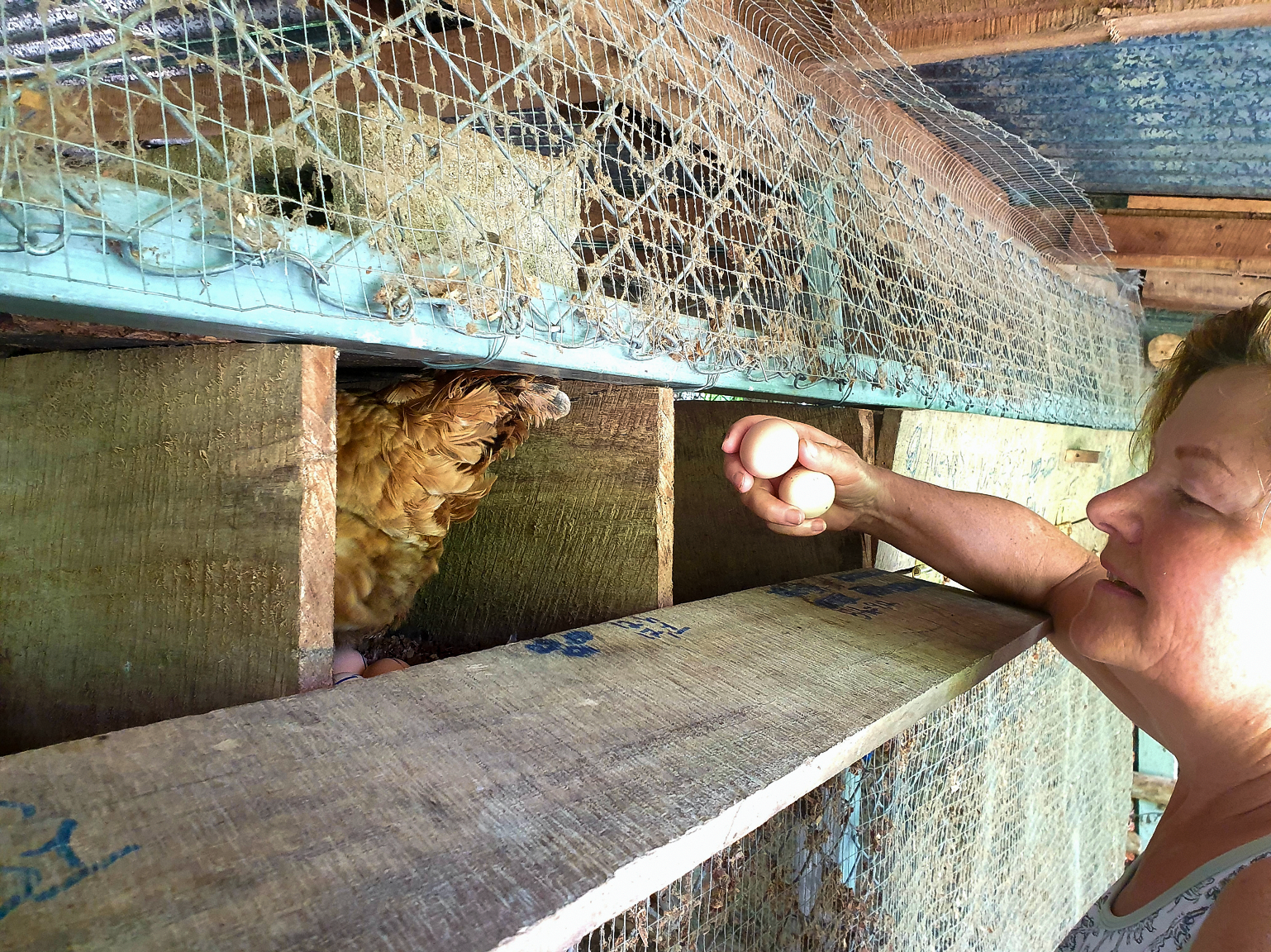
Nest boxes that can be accessed from the outside.
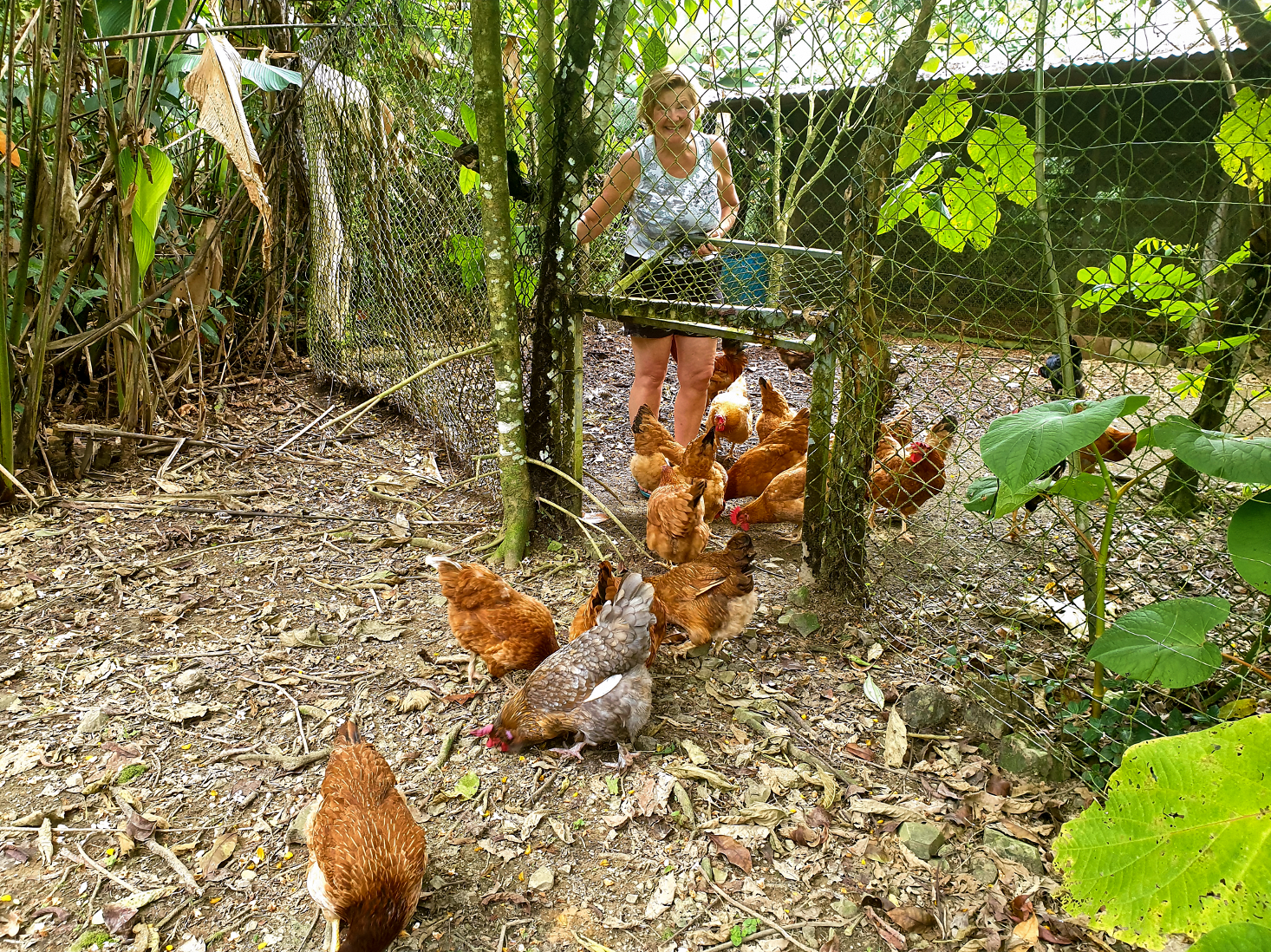
During the day, they leave the enclosure to feed on fallen fruits, weeds, and insects in the food forest. This way we also minimize the need for food from outside sources.
At dusk, they return by themselves into their safe enclosure for the night.
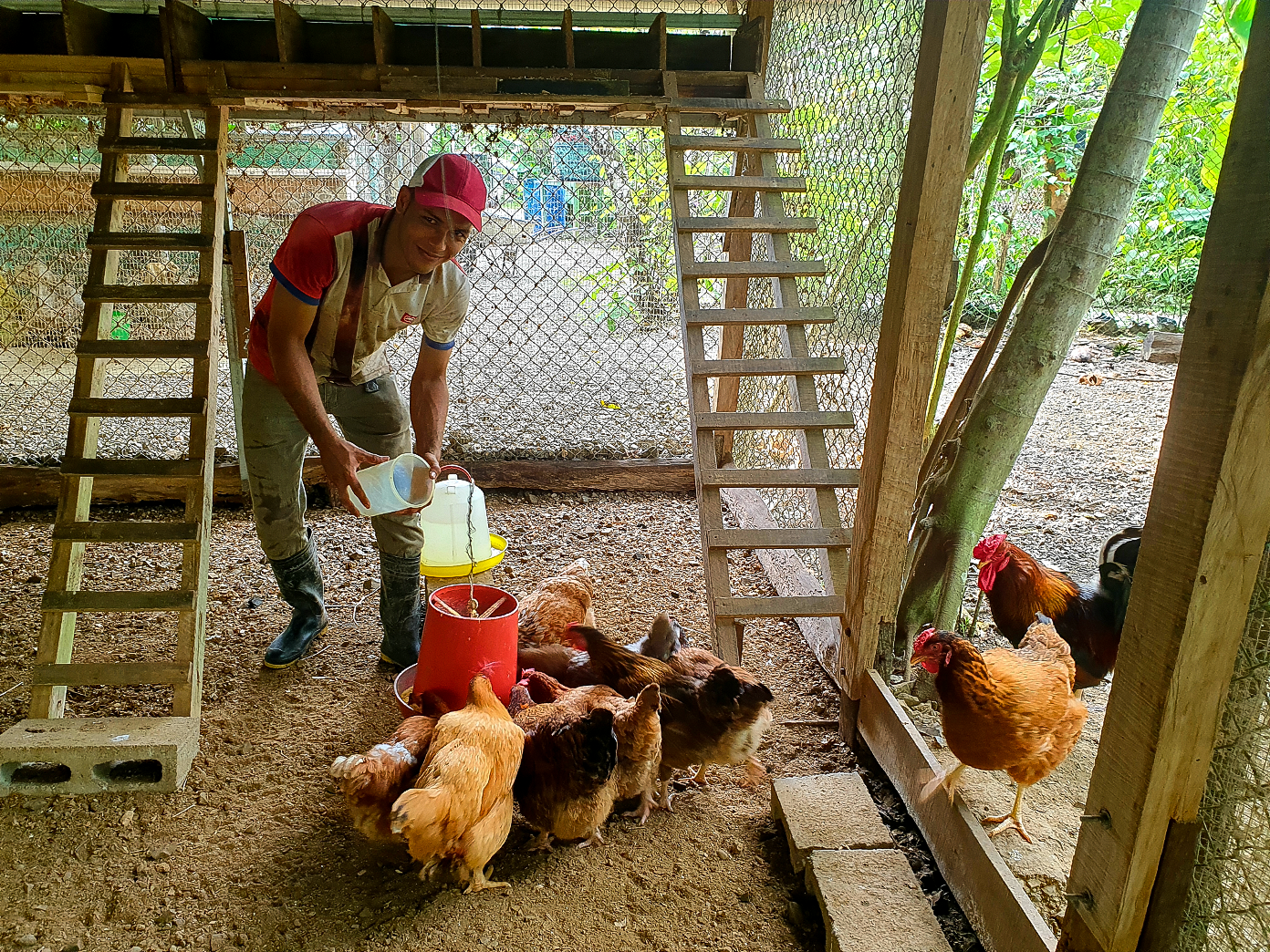
When they are still hungry, we feed them corn and fermented rice as a special treat. Fermented rice is much more nutritious than regular rice, so chicken need much less of it. Changing their water twice a day is essential for their health.
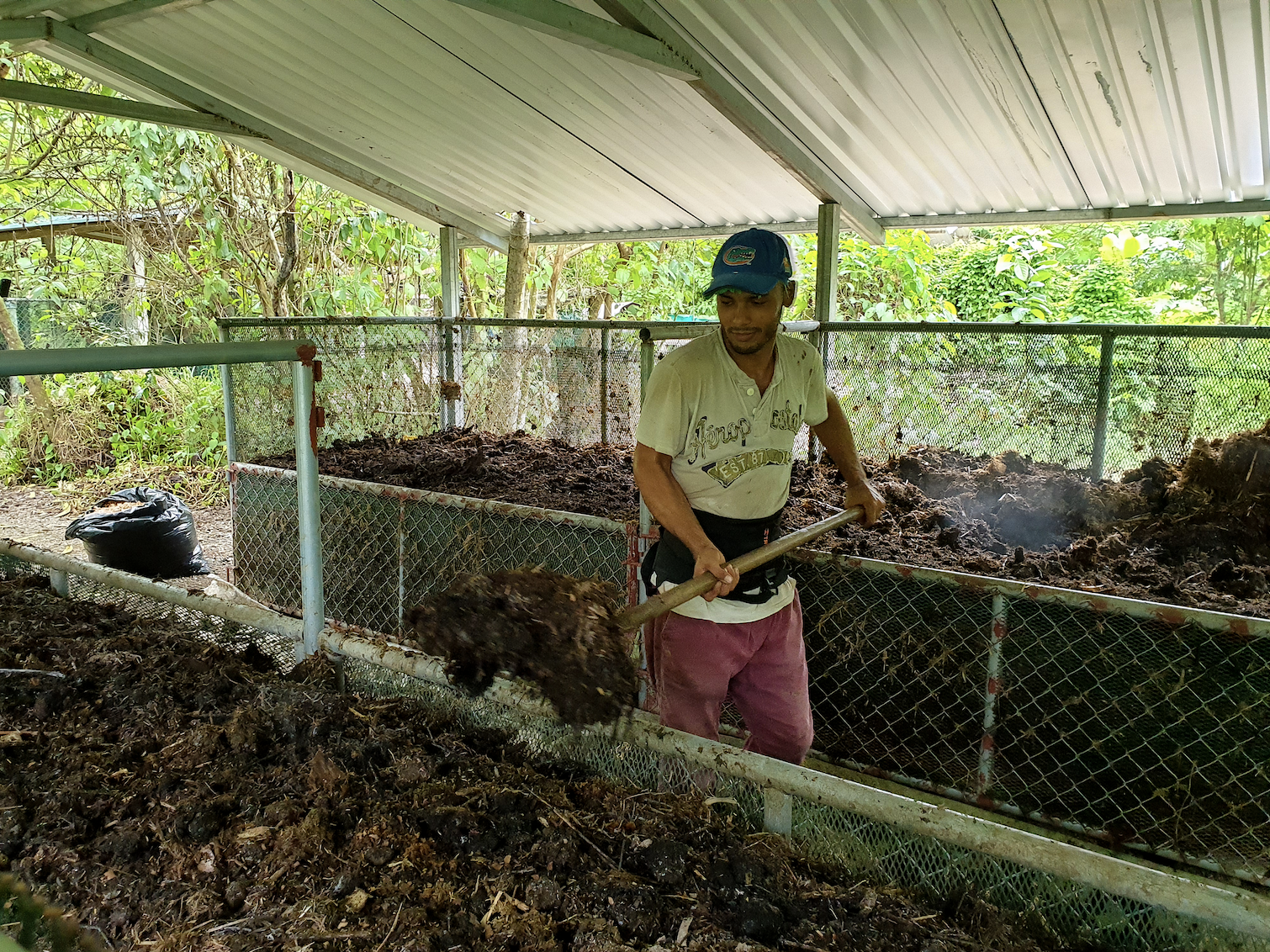
Among all dungs, chicken dung is arguably the most valuable due to its high content of nitrogen, phosphorus, and a host of many other minerals. Their dung is composted, turning it into highly fertile earth in which a variety of new food can be grown: the cycle is closed.

Tree nursery
Tree nursery
Our tree nursery supports the ambitious goal of AMISTOSA, a government program to reforest the biological corridor between Osa Peninsula and La Amistad National Park, which comprises around 50,000 hectares.
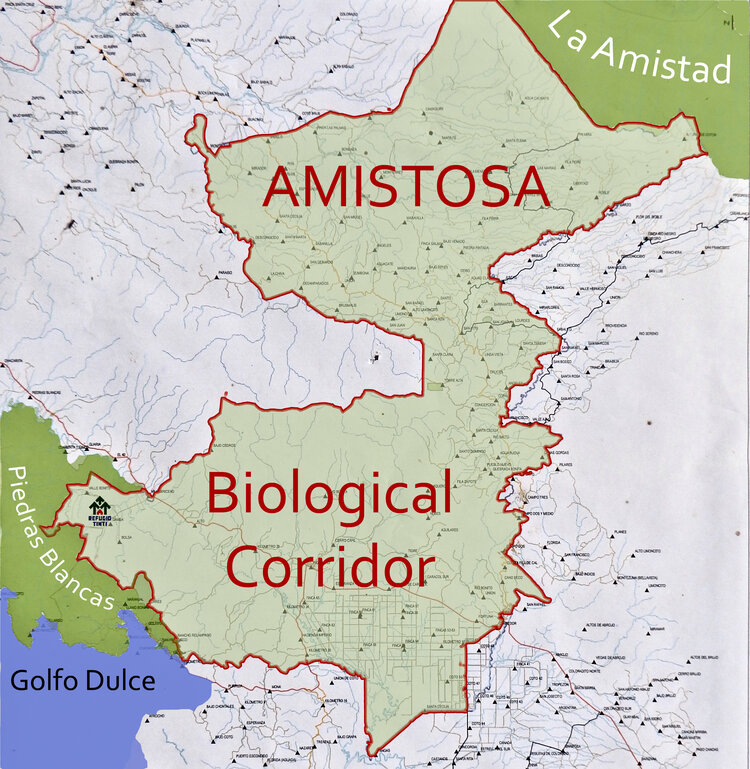
As a start, we made space for around 3,000 seedlings per year, currently focussing on over 20 different species threatened by extinction.
Under one tree in the forest, hundreds to thousands of seeds and seedlings can be found. We collect never more than 10% at one location. The majority of the remaining seeds is eaten and dispersed by various animals.
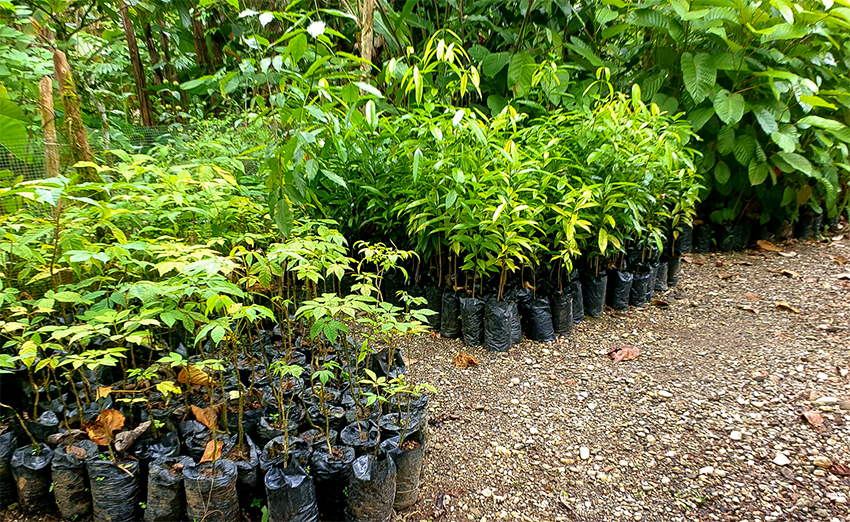
Seedlings need between 6 months and 2 years before they can be planted out. During this time they grow in our biodegradable bags.
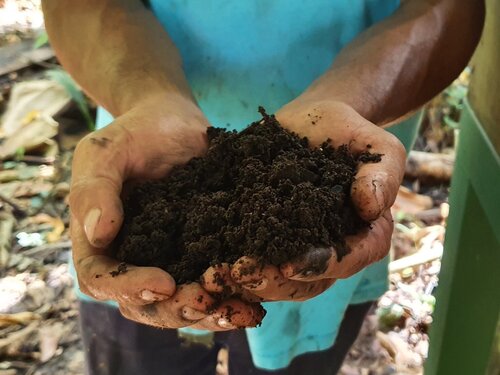
To ensure their health we grow them with our finest worm compost.
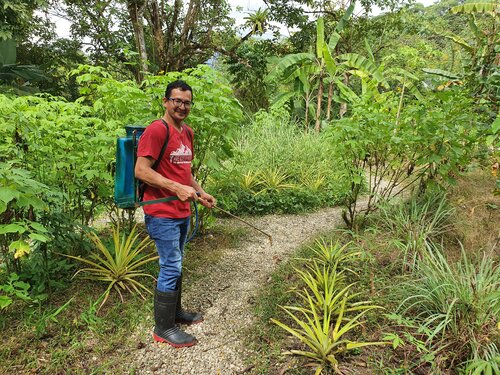
We douse them regularly with our compost tea and occasionally with a solution of our wood vinegar to protect them from various fungi.
Once they are planted out, they need 3 to 5 years of care until they shade out the weeds and are strong enough to be left on their own.

Microorganisms
Microorganisms
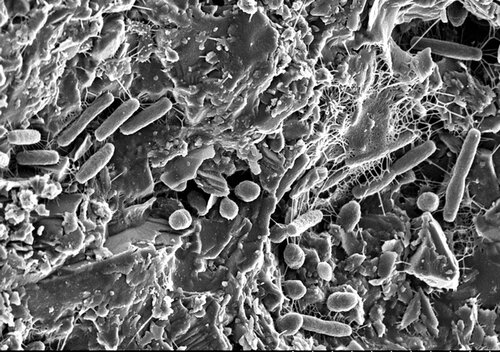
Microorganisms are arguably the most crucial factor in our reforestation efforts. They transform decaying organic material into nutrients that can be taken up by plants, they regulate the ever-changing pH-requirements of growing trees and, applied as a leaf spray, provide fertilizer and protect leaves from many bacterial and fungal diseases.
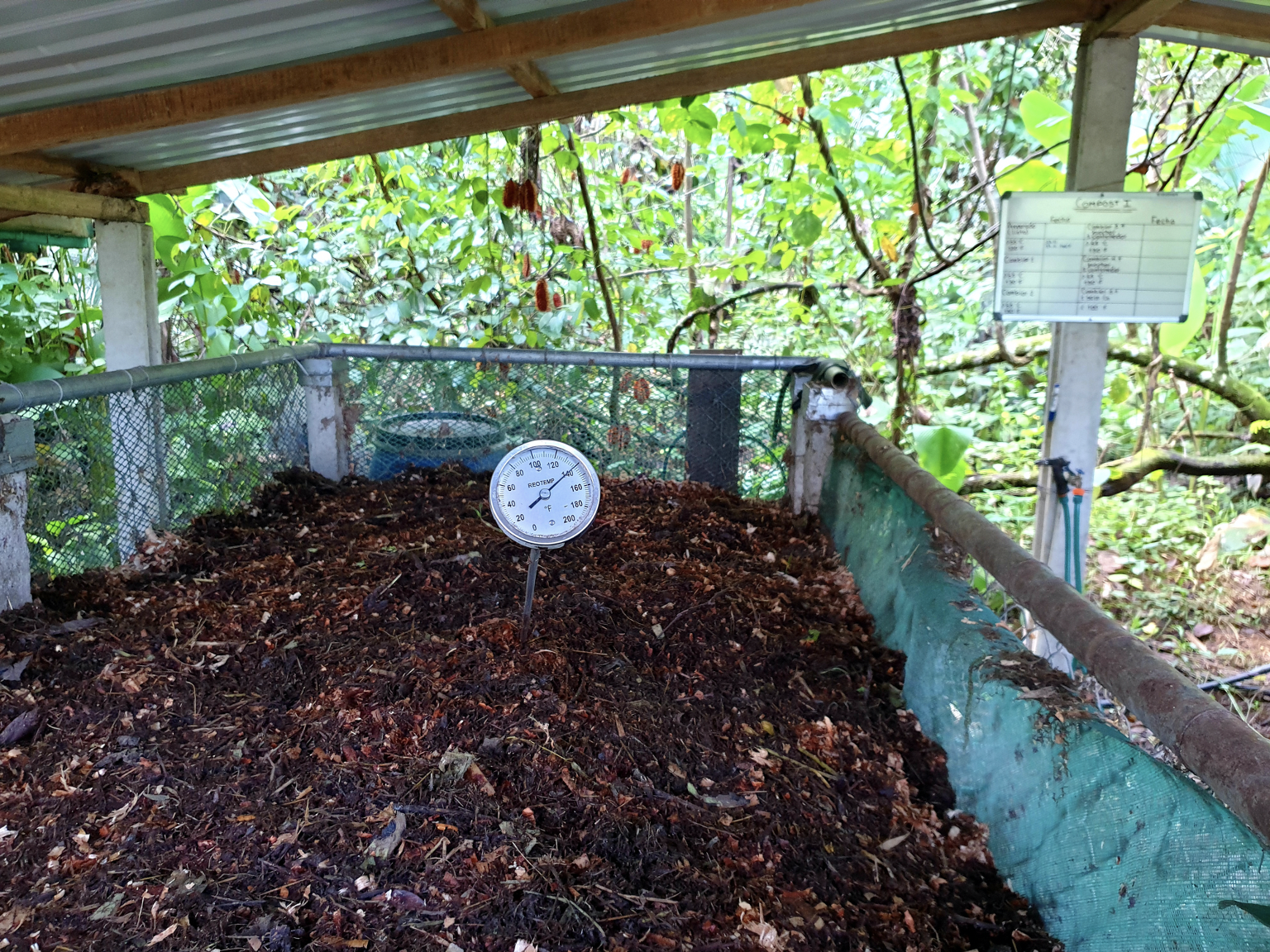
To increase the number of microorganisms in the soil, we produce them through heat composting.
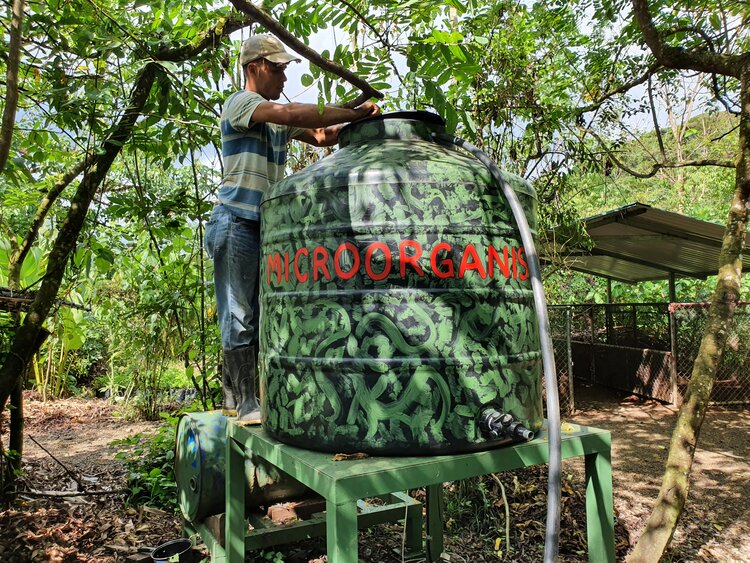
We multiply them through compost tea.
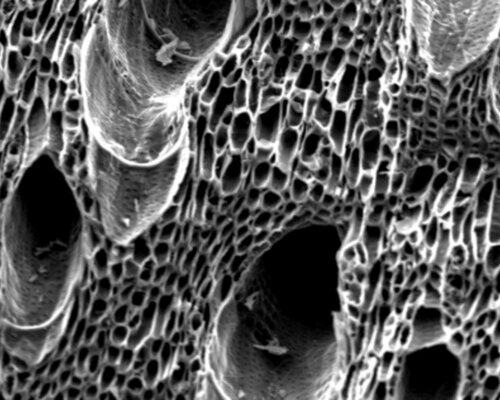
Finally, we provide shelter for them with biochar. The tiny microorganisms retreat into the many holes and cavities of the biochar and attach themselves to its huge surface.
Microbial activity in the soil is greatly reduced through the use chemical fertilizers and badly affected by pesticides and herbicides.

Water tanks
Water tanks
We are connected to the village water, which comes in drinking quality to our faucets. As the water pressure is minimal, we use gravity to avoid the need for a pump: we took a hose and climbed a tree to find the highest altitude where water still trickles from the hose.
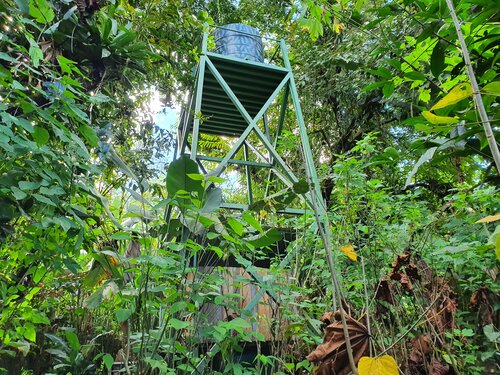
We then built an 8-meter-high structure and put two tanks with 2,500 liters each on top. Over night, the trickle fills them up, so there is always more than enough water for all of us.
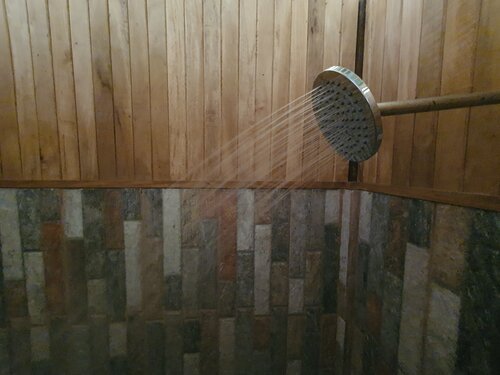
It is discharged with good pressure into all buildings. In addition, chlorine has had time to evaporate before it reaches our faucets.

Vanilla
Vanilla
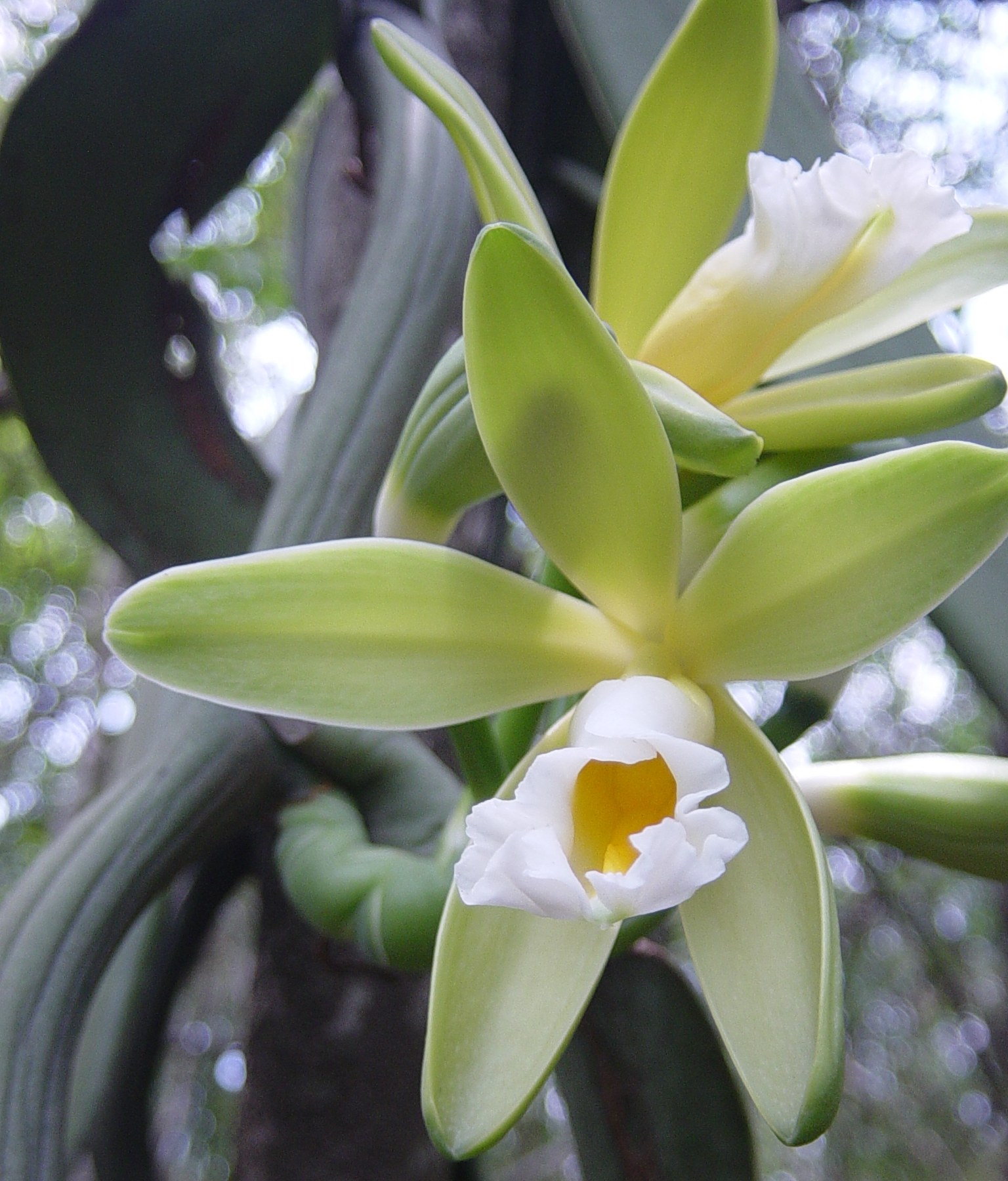
Vanilla is a climbing orchid in tropical forests which in the wild is threatened by extinction. Vanilla is cultivated now all over the tropical world, but originated in Mexico, where it co-evolved with a bee species of the genus Melipona, their only pollinator. As these pollinators haven’t successfully been bred in any other country than its native Mexico, vanilla must be pollinated by hand in order to produce beans. This highly sophisticated process has been invented by Edmond Albius, a 12-year old child slave in 1841 on the island of Réunion. The complicated and labour intensive process of growing, pollinating and curing makes vanilla the second most expensive condiment in the world.
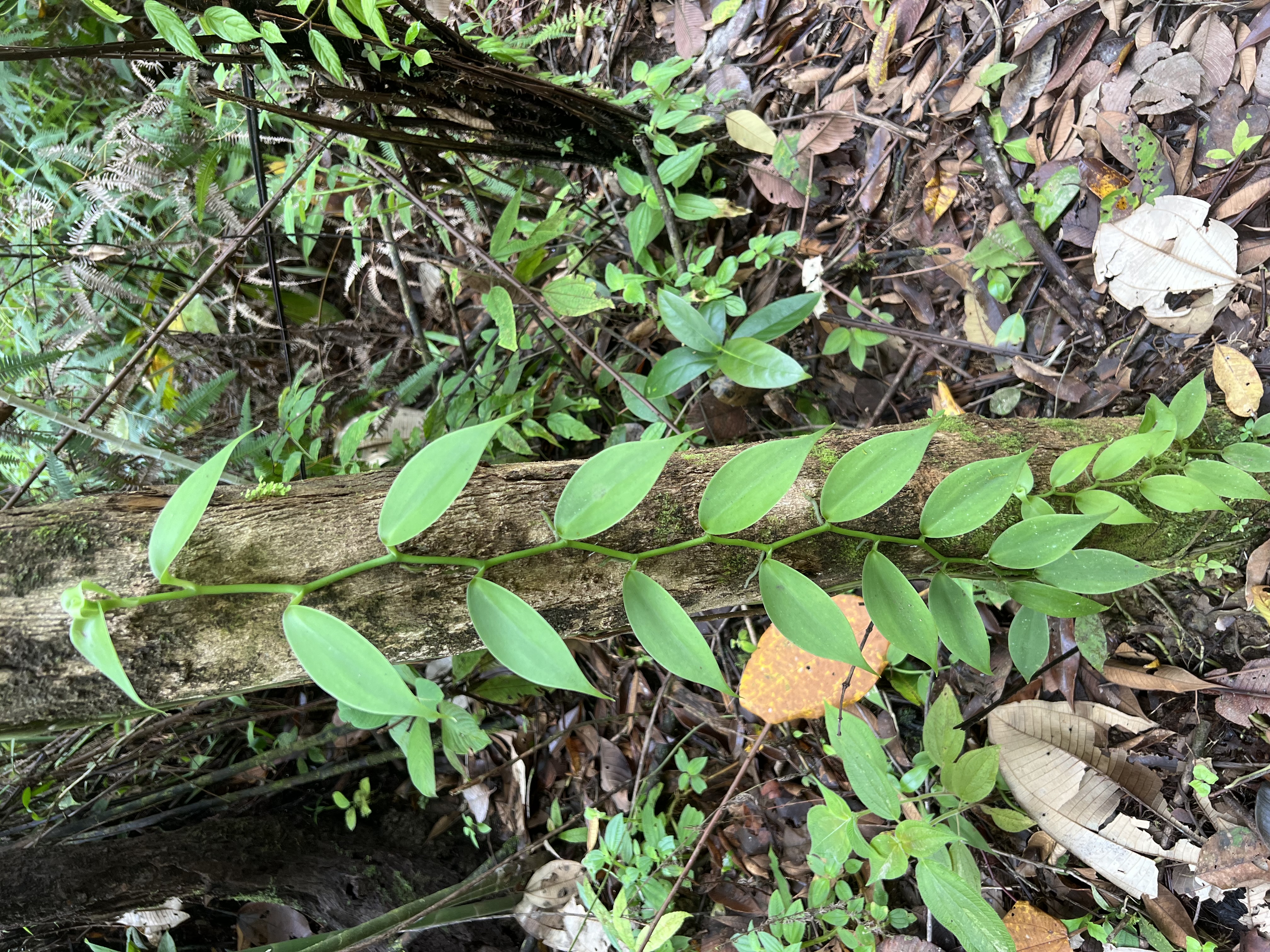
Vanilla grows in the shade, so we in the Refugio let them climb on the stems of trees in our primary and secondary forests. So far we planted over 150 plants with probably many more to come. Vanilla takes 3 to 5 years to bear fruits.
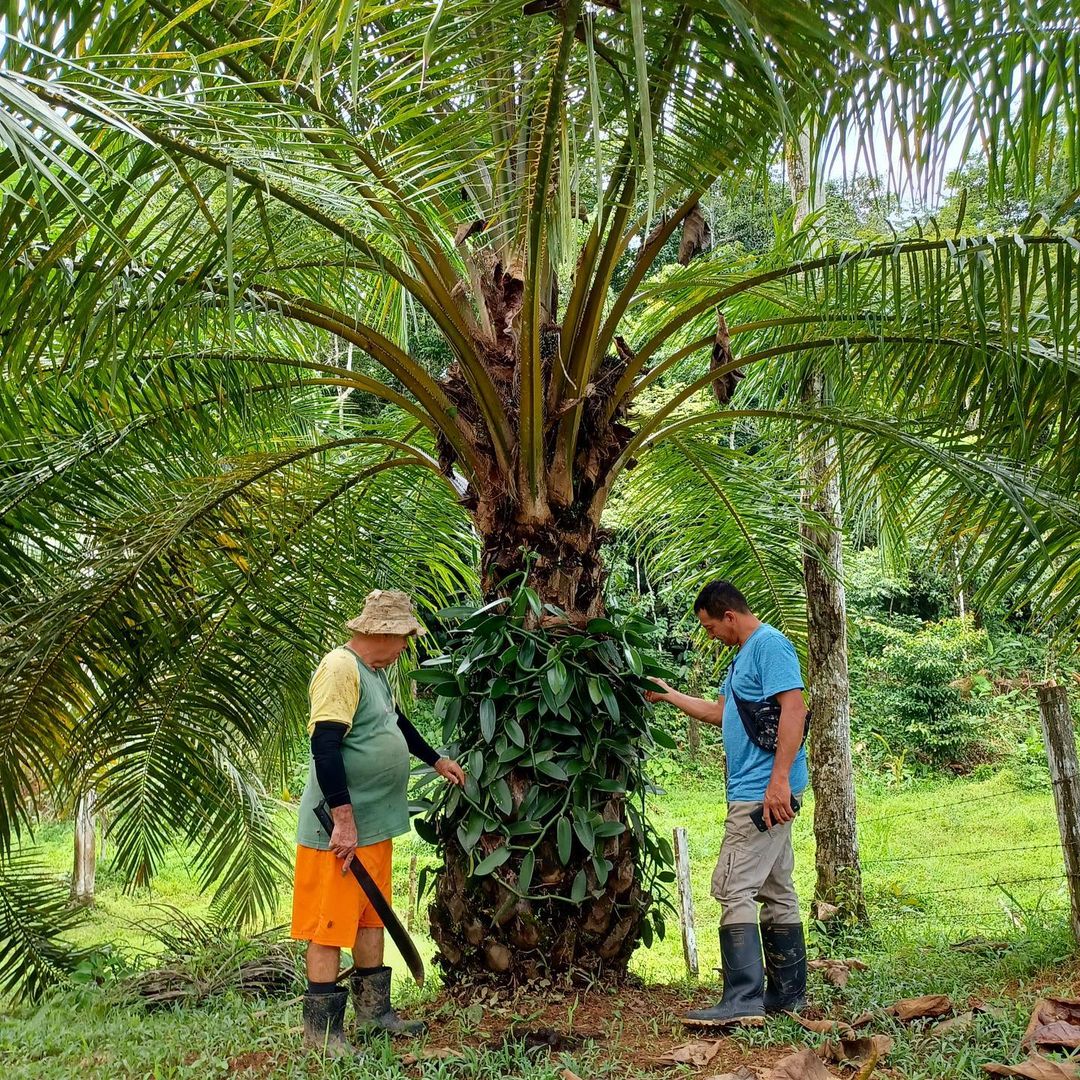
Because of its high value we also included vanilla into our concept of replacing monocultures with forest gardens.

Solar dryer
Solar dryer
Drying herbs and banana chips is a highly energy-consuming process resulting in high electricity bills.
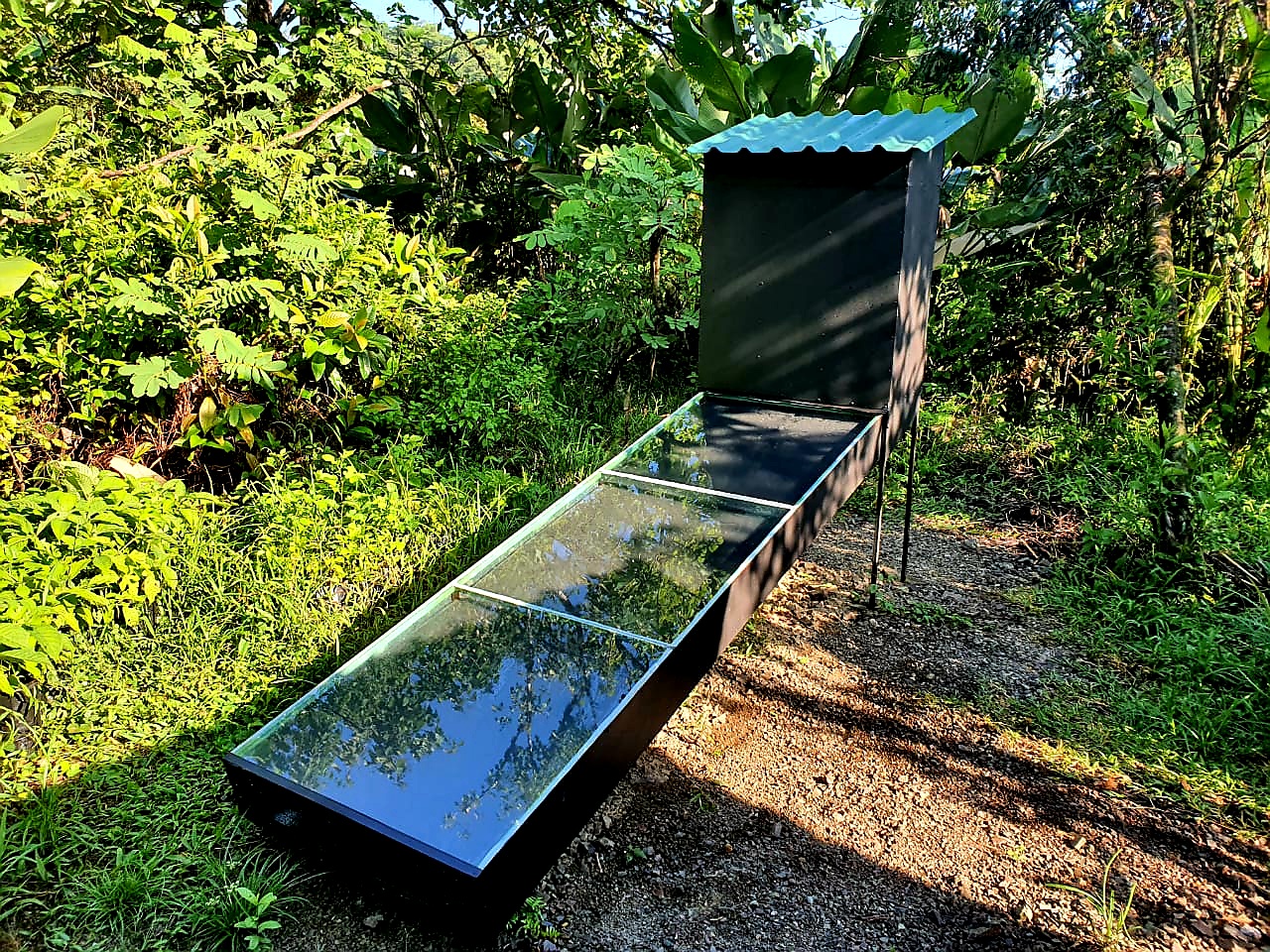
Our solar dryer collects the sun's thermal energy and does the job for free! It consists of a ramp and a chamber.
The ramp has a transparent glass top and is lined with black felt on the inside. Sun rays penetrate the top and heat the air within the ramp from where it rises and heats the chamber.
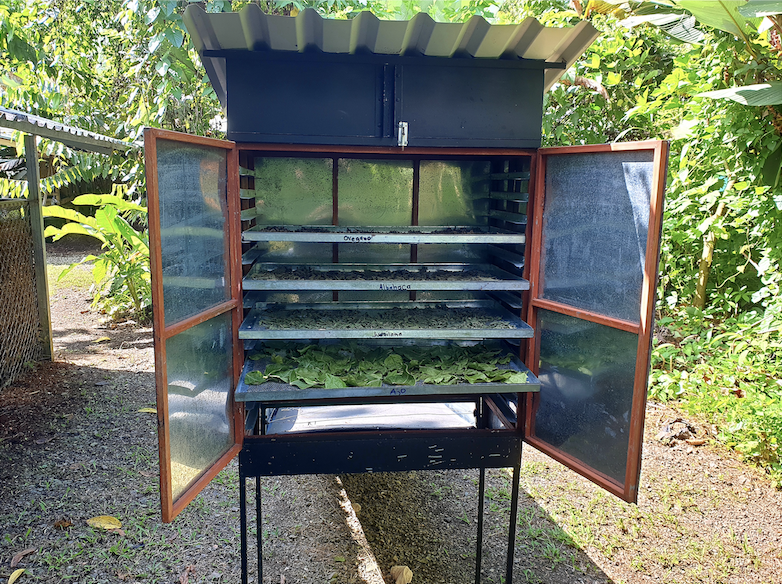
The chamber contains several drawers on which herbs and banana chips are laid out. The temperature in the chamber heats up to almost 50°C (122°F) on a sunny day, hot enough to dry the herbs and banana chips within a couple of days.
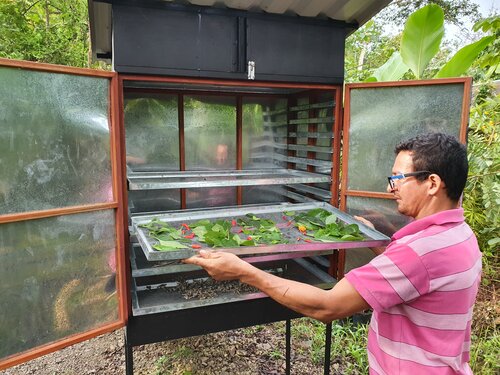

Composting toilets
Composting toilets
In line with nature's principle of not wasting anything and recycling everything, our toilets are all composting toilets. Instead of flushing down valuable nutrients with (in most cases) drinking water while at the same time polluting the groundwater, lakes, rivers, and oceans, we safely compost them and benefit from their valuable nutrients for our plants. According to the WHO, one out of three people worldwide has no access to save drinking water – dry toilets are a great starting point to tackle this challenge!
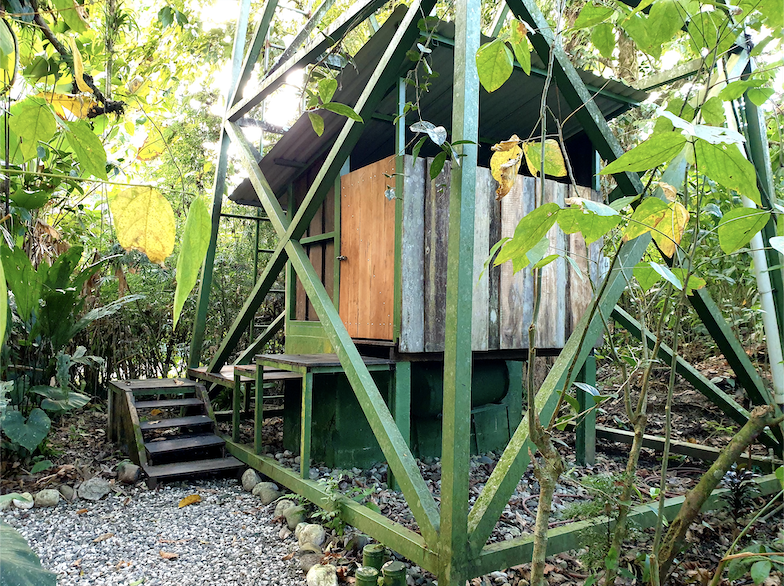
The process is simple:
Take a bucket and fill it with a layer of wood shavings.
After the business is done, it is covered with a few handfuls of wood shavings, and so it continues until the bucket is full. Its contents are then put into one of two large containers where it continues composting.
Every time a bucket is emptied into a container, we mix biochar and beneficial microorganisms into it and let them work for another few months until it entirely turned into earth.
And finally – just to be definitely on the safe side – we hot compost it again before using it as fertilizer.
We then use it around our trees – the cycle is closed!

Worm compost
Worm compost
Worms metabolize just about anything organic and are an efficient element to recycle kitchen scraps not only into the finest compost, but also into a liquid called 'worm juice'.
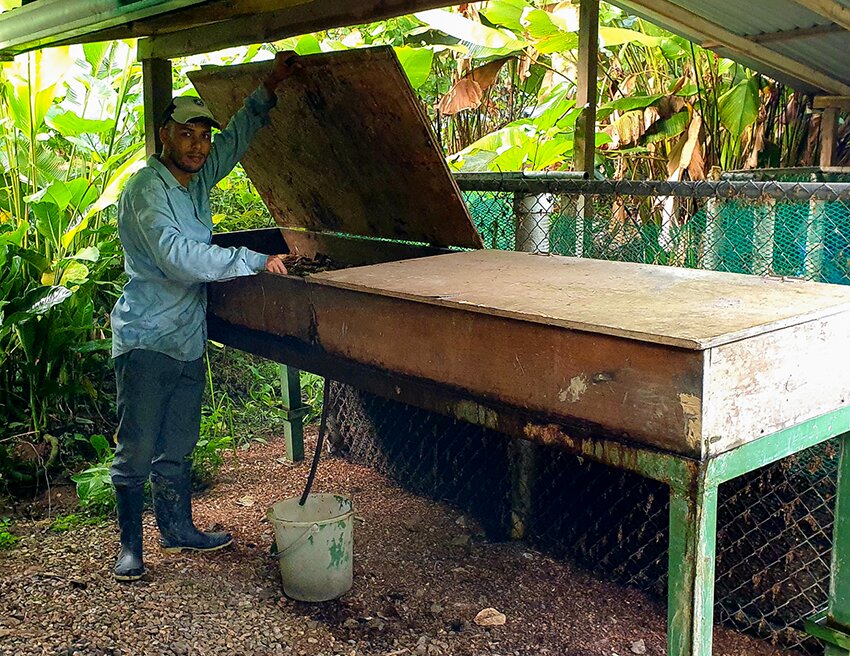
The worm box has two chambers. The separating wall has holes through which the worms can migrate. As long as there is enough food in one chamber they will stay there and multiply. If we want to harvest the compost, we feed them in the other chamber and once they all migrated there, we harvest the compost from the first.
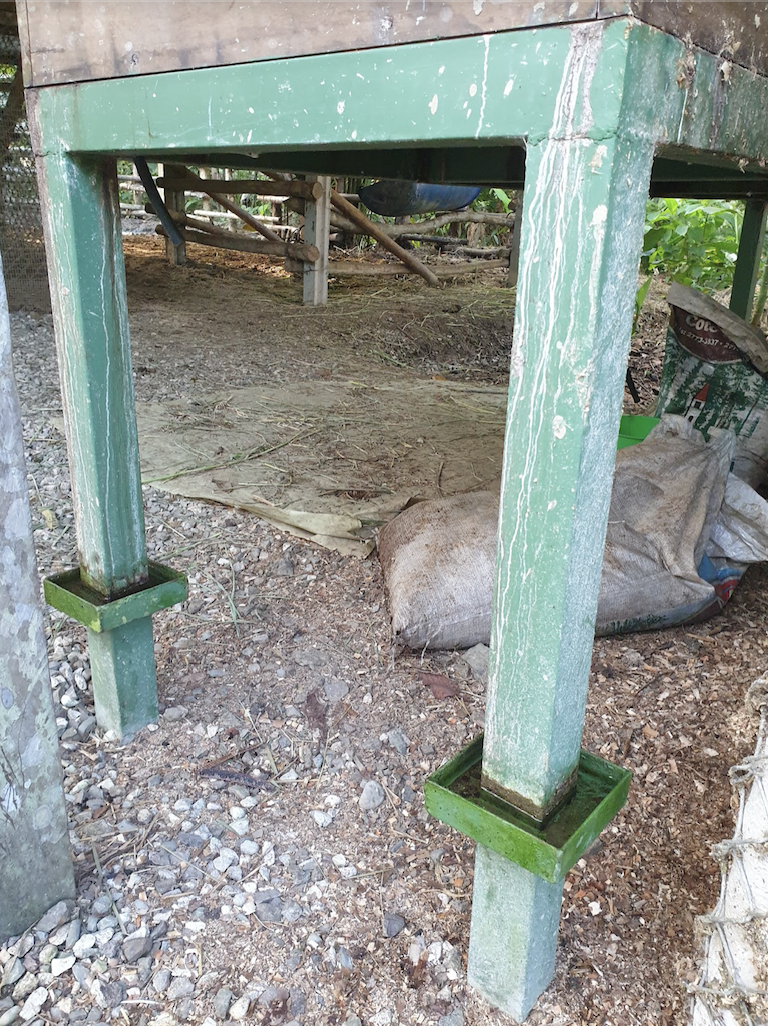
Our worm box is on stilts. Since ants are one of the biggest enemies of worms, each stilt is surrounded with a small receptacle, filled with water, that ants cannot cross.

Worms transform calcium compounds that are unavailable to plants into such that can be uptaken by them. Worm compost is particularly good for seedlings.

Biochar
Biochar
Biochar is charcoal made out of wood and other carbon materials through a process called 'pyrolysis' (heating of organic material in the absence of oxygen) and injected with soil microorganisms. It is used as a soil amendment where it functions as shelter for microorganisms.

The microorganisms attach themselves to the huge surface of the biochar and take refuge from amoebas and other predators in the cavities. In the soil they function as 'cooks' for the plants by turning organic material into inorganic compounds that can be taken up by plants. It cannot be assimilated by plants – once in the soil, it can remain there for thousands of years.
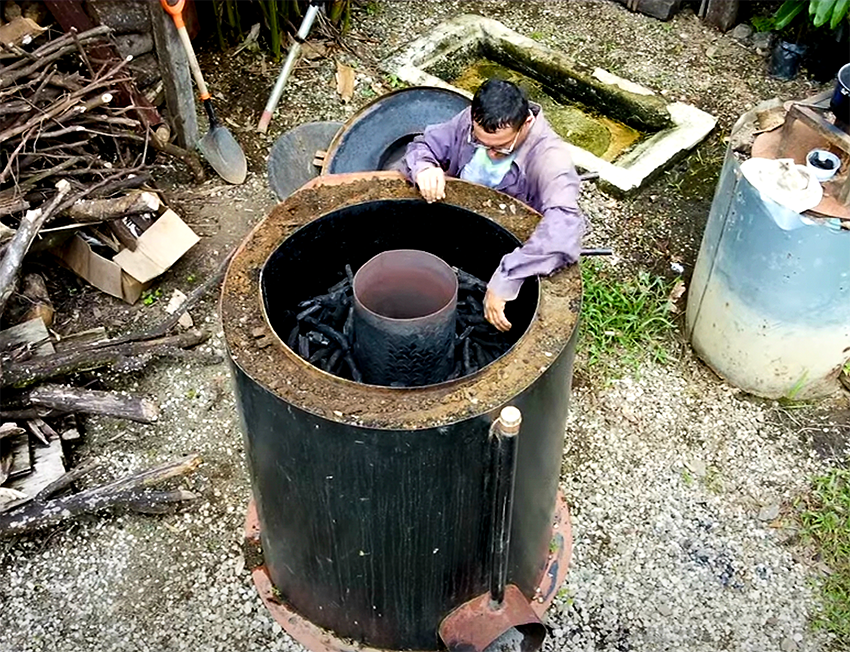
Our biochar kiln consists of three chambers:
a. the inner chamber where some wood is fired up to initiate the process
b. the middle chamber where the carbonization takes place
c. the outer chamber, filled with earth, to isolate against heat loss
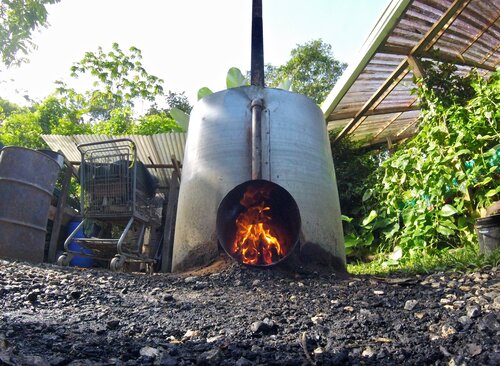
The inner chamber is fired up and through its wall, it heats the wood in the middle chamber.
As the wood heats up, it starts to give off 'wood gases' which are combustible. They have no path to escape except through the small tube leading along the outer wall back to the inner chamber, where it is sucked in and takes over the fire from the original firewood.
By burning these gases, more wood in the middle chamber is heated up, giving off more and more wood gases.
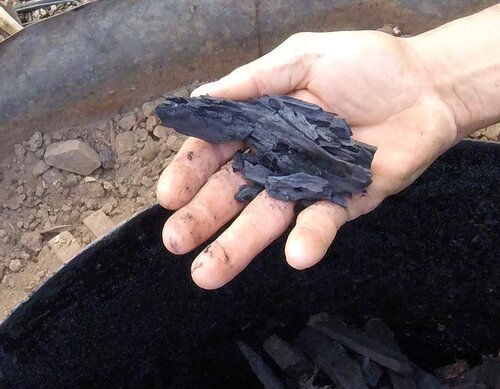
When the fire dies down, the process is complete and 90% of the wood has turned into charcoal.
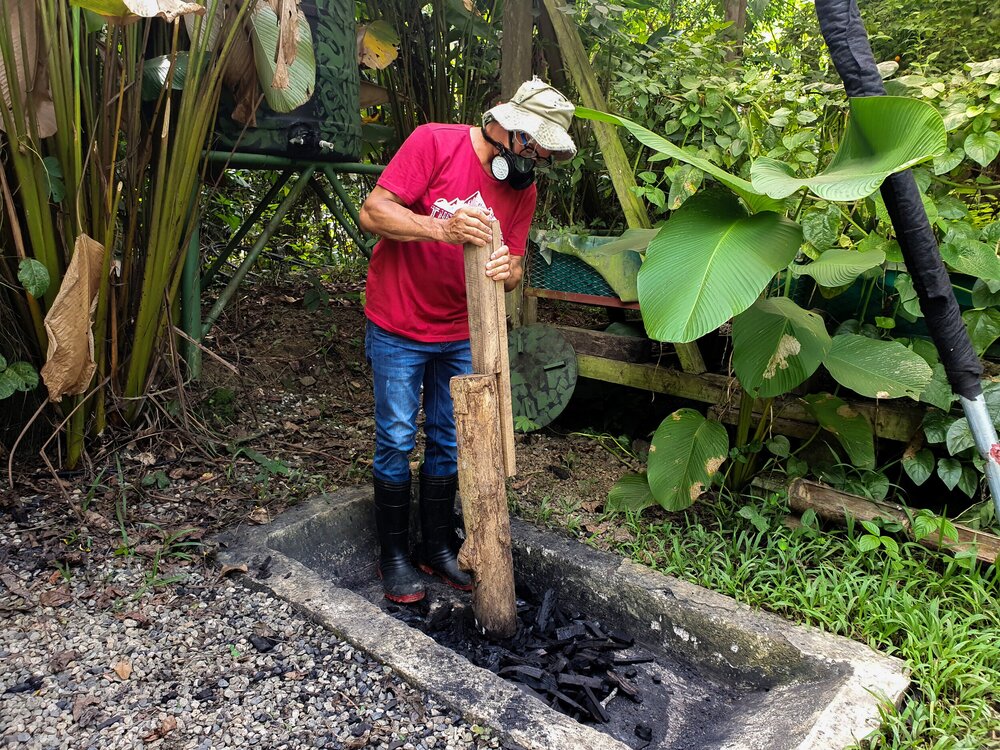
Next, it needs to be pulverized.
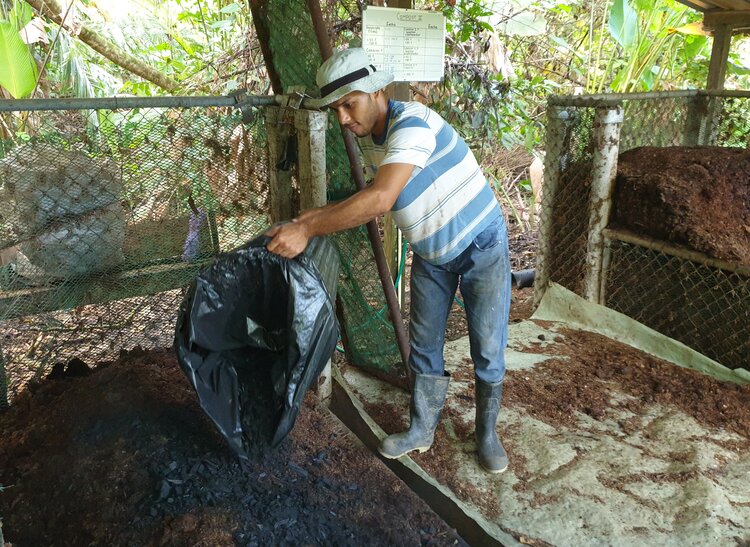
Then, the charcoal is inoculated with microorganisms. To do so, we mix it under our compost pile while it is cooling down.
After about six weeks, the charcoal is saturated with microorganisms and the charcoal-infused compost is ready to use.
Wood Vinegar
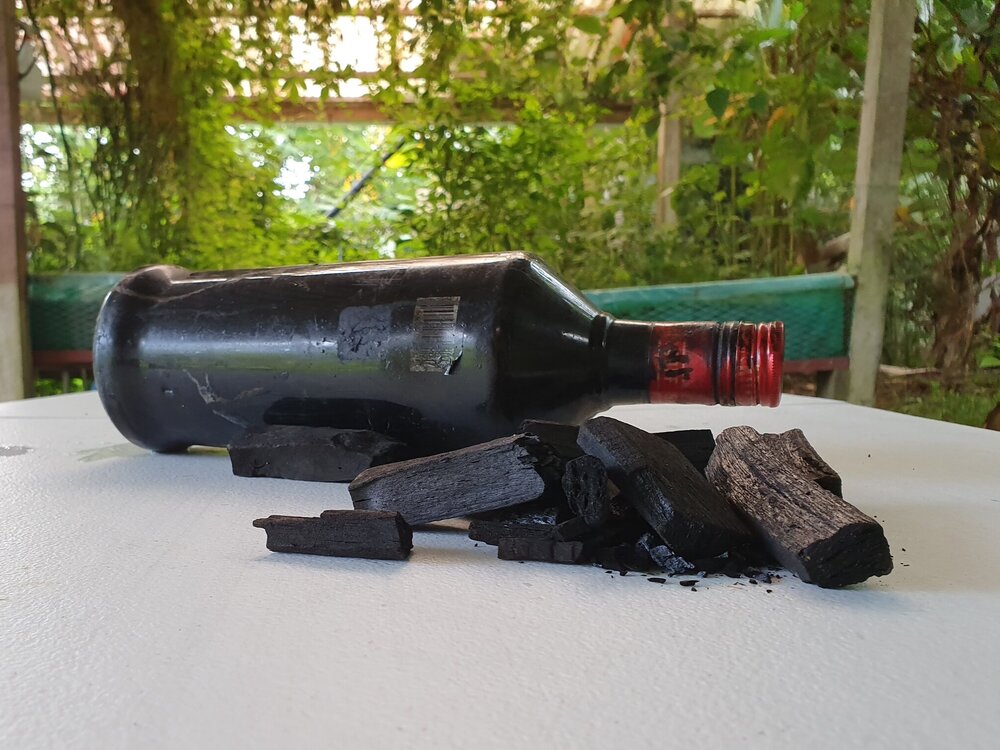
Wood vinegar (pyroligneous acid) is a very valuable byproduct of the biochar production.
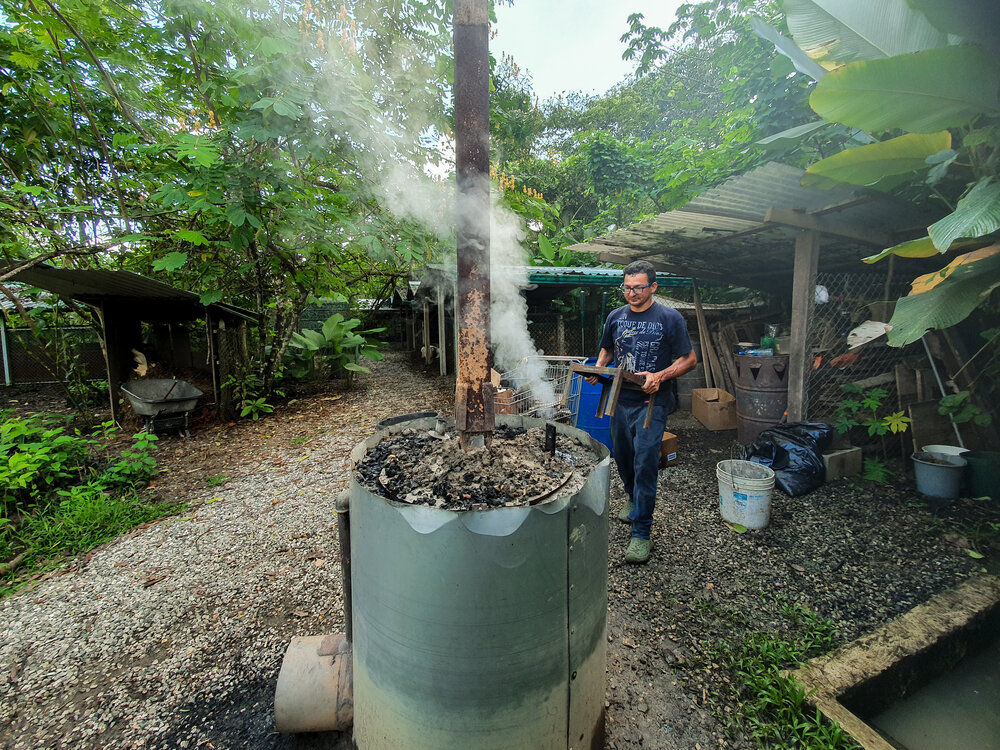
Every wood contains some moisture that is given off during the initial process of heating up.
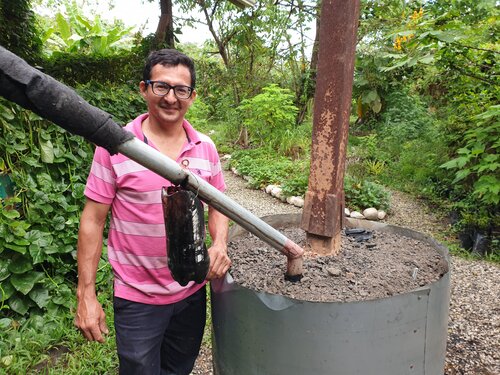
This steam, full with minerals from the wood, is guided through a long narrow pipe. As the steam rises, it cools down, condensates and flows down the pipe where we collect it through a little hole.
Wood vinegar, diluted in different ratios, can be used as fertilizer, biodegradable fungicide, and even as medicine.

Compost tea
Compost tea
Compost tea is a way to multiply beneficial soil microorganisms.

First, a large tank is filled with (unchlorinated) water.
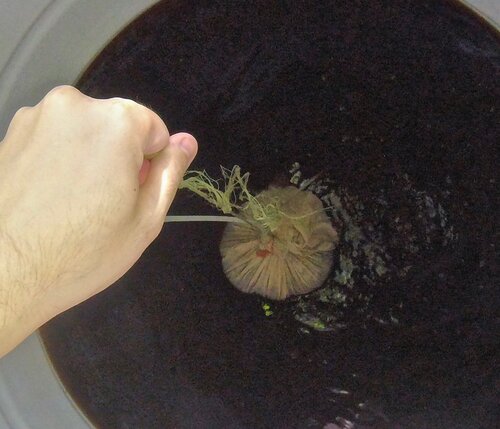
A few handfuls of mature compost are put into a bag-shaped mosquito net and using a string, it is lowered into the water. An aerator is put on the ground of the tank.
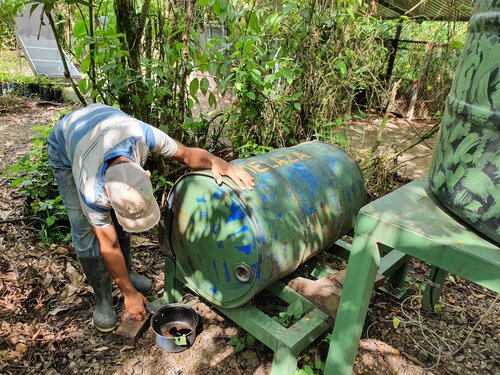
Two liters of (unsulphured) molasses is mixed into the water as food for the microorganisms. After 24 to 36 hours, the microorganisms can be harvested. The liquid is diluted in a ratio of 1:10.

Sprayed on the ground, it raises the fertility of the soil. Sprayed on leaves, it protects the plants from a variety of fungi and other diseases.

Hot compost
Hot compost
Microorganisms are the basis of all of our restoration efforts. In a method called 'hot composting', we breed beneficial soil microorganisms.
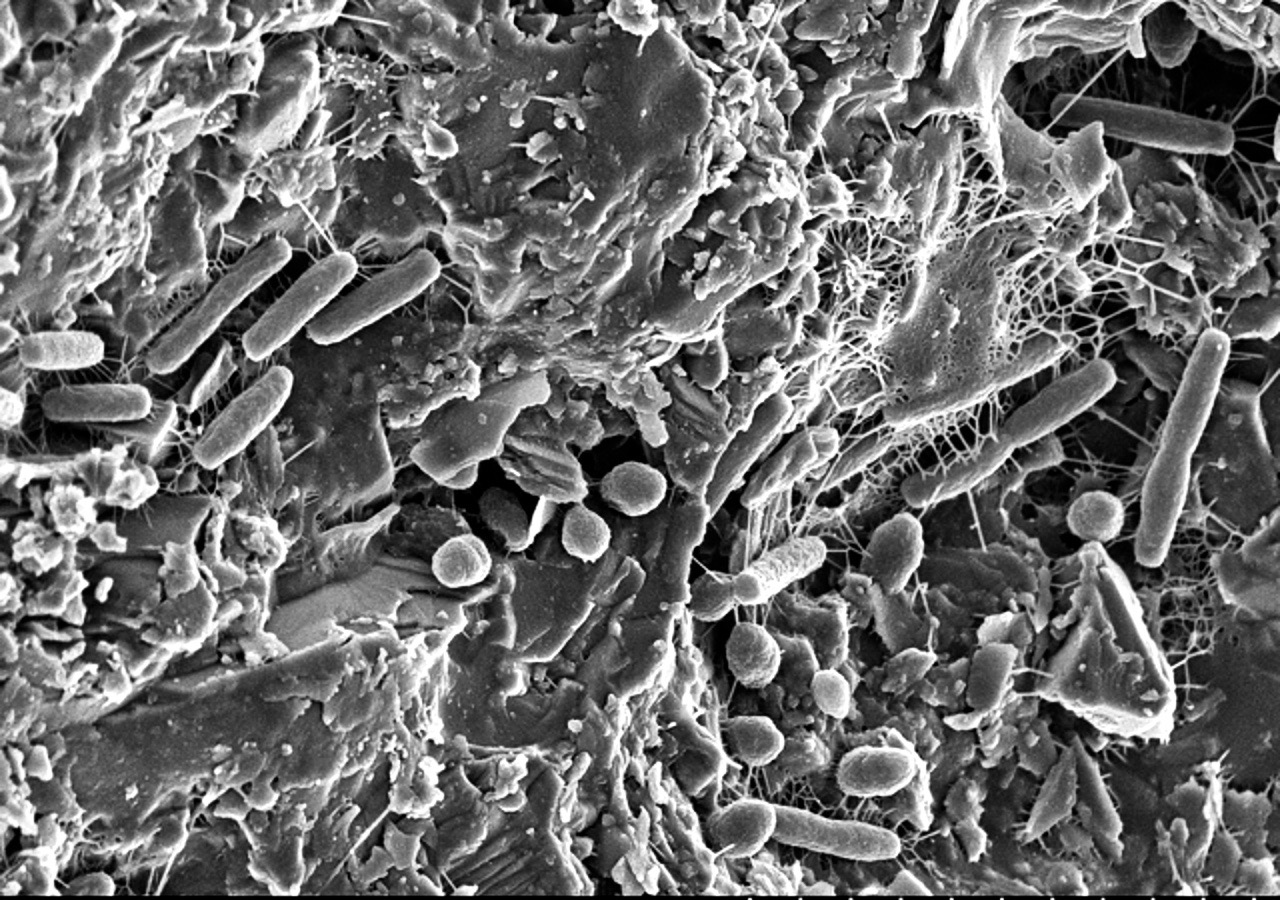
Heat in a compost pile arises when the soil microorganisms multiply. These microorganisms then function as 'cooks' for the plants, transforming organic material into inorganic compounds that can be taken up by plants.
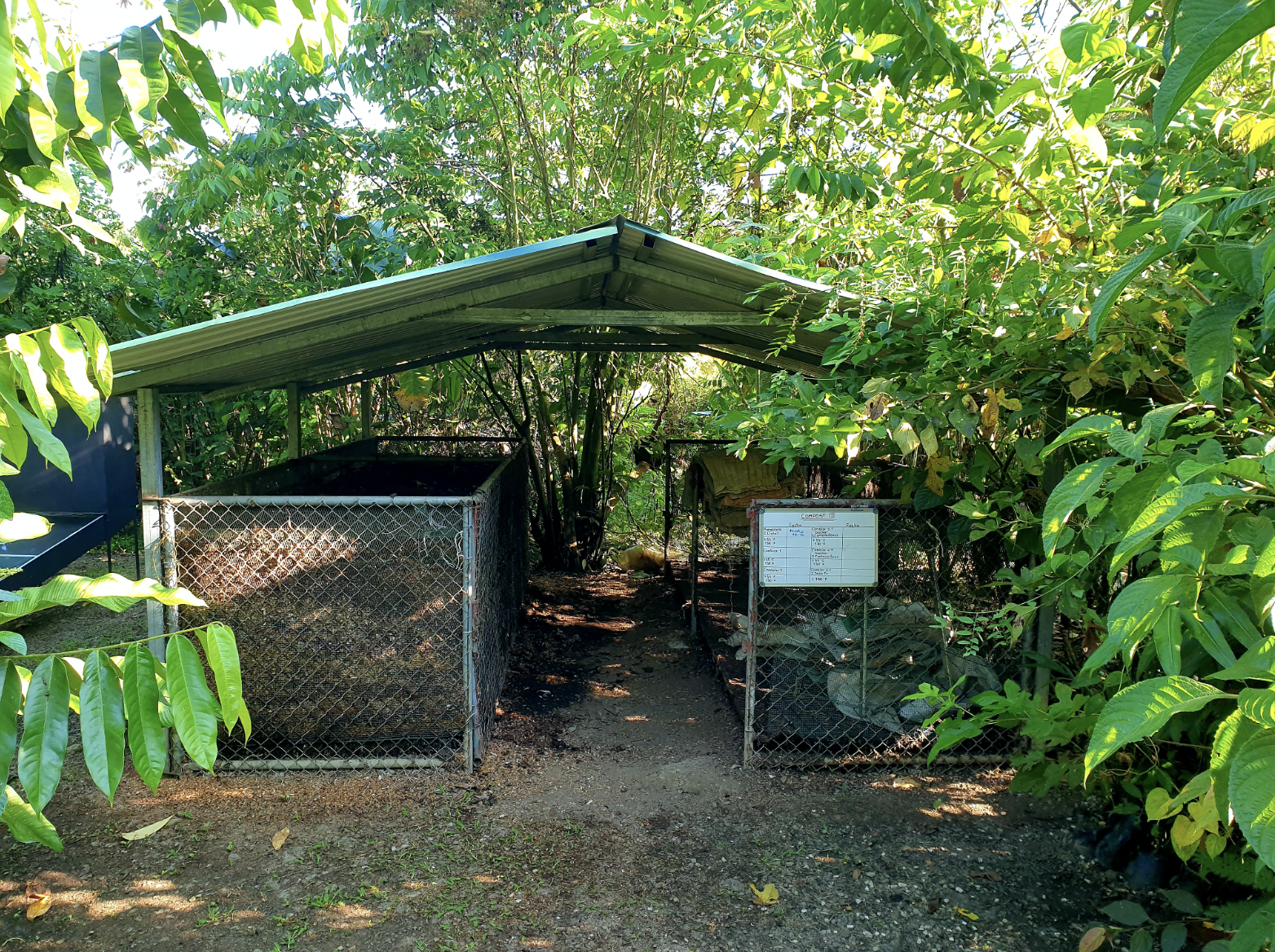
As the compost needs to be turned over from time to time, two compost structures are needed.

The required temperatures (55-65°C, 130-160°F) are achieved through the correct ratio between material containing carbon and nitrogen as well as the correct moisture. Above a temperature of 55°C (130°F), virtually all pathogens and weed seeds die. If the temperature rises above 65°C (160°F), carbon-rich material must be mixed under, if it stays under 55°C (130°F), nitrogen-rich material must be added.
Carbon sources are saw dust, dry leaves, and hay as well as paper and cardboard (no colors and inks!). Nitrogen sources are all kinds of dung, green leaves, grasses, and kitchen scraps.
The moisture is correct if a handful of compost, when squeezed, releases just a few drops of water.

After the temperature rises to 55-65°C (130-160°F), wait three days and then turn over the compost for aeration and add (unchlorinated) water or compost tea. After the fifth turn and a cool-down period of a few weeks the compost is ready to use.

Mexican sunflower
Mexican sunflower

The Mexican sunflower (Tithonia diversifolia) is one of the linchpins in the recovery of our initially abused and degraded soils. It fixes nitrogen from the air and draws phosphorus from the depths of the soil.
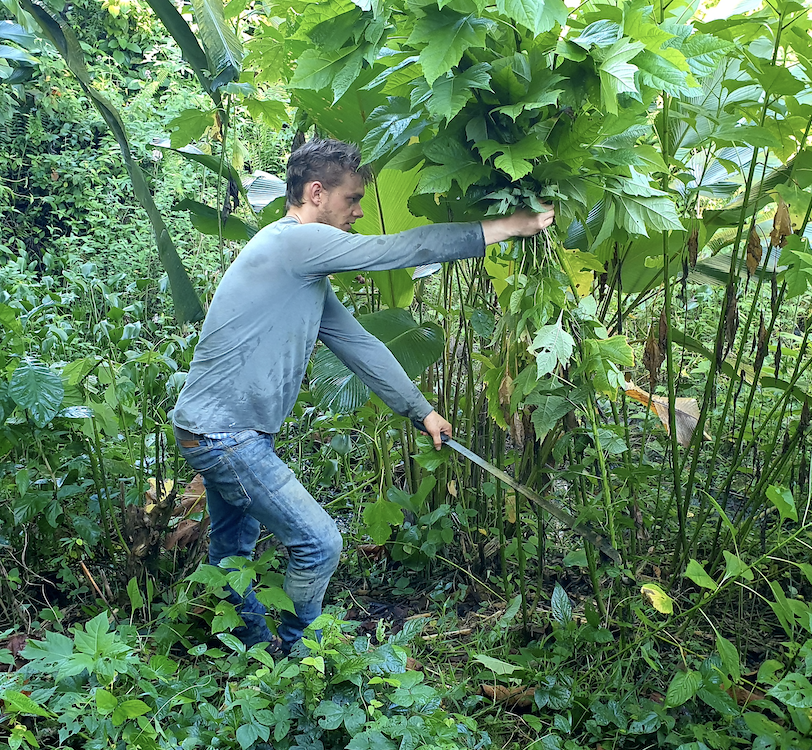
The Mexican sunflower grows fast: once every two months, around full moon, we prune them to about half a meter from the soil and distribute the phosphorus- and nitrogen-rich material around the planted trees.

As the trees grow and their roots are strong enough to draw a sufficient amount of nutrients themselves, their canopies close and the Mexican sunflowers, having done their duty, are shaded out.
If you want to learn more about the fascinating mechanisms at work in the Mexican sunflower, have a look at our blog post here.

Food forest
Food forest

Our food forest consists of a mix of a large variety of different fruits, nuts, wood and forest species.
Our aim is to become as self-sufficient as possible and we are well on the way: we are harvesting already bananas, plantains, papaya, maracuya, Inca nut, water apple, pineapple, rambutan, coconut, star fruit and cacao. We are soon expecting pudding fruit, breadfruit and cas.

We surround each seedling with Mexican sunflowers (Tithonia diversifolia), a fast growing shrub that not only fixes nitrogen from the air but also extracts phosphorus from the soil's depth. Phosphorus was the most depleted element in our soil.

In addition we welcome so-called weeds as indicators for what's missing in the soil. Like the Mexican sunflower, they draw nutrients from the depths of the soil where young and more delicate trees can't reach them yet.
Regularly cut back, they provide the growing trees with all nutrients they need. As the trees are growing and the canopy closes, the weeds and Mexican sunflowers are eventually shaded out.

Vegetable and herb garden
Vegetable and herb garden

To meet the challenge of growing vegetables in a swamp, we adapted the ancient Mexican method of 'chinampas': we excavated deep drains and piled the earth in between the drains where the vegetables can grow.

We filled the drains with large river pebbles and wrapped them in a netlike material to prevent erosion. We then topped it with gravel to allow for a double-functioning as paths. The paths/drains are curved to enrich the flowing water with oxygen, which attracts beneficial microorganisms that clean the water on its way through the drain.
To deter pests we alternate vegetables with strong-smelling herbs.
We currently grow sweet potatoes, Brazil spinach, cucumbers, malabar spinach, okra, katuk, sacha inchi, pumpkin, tomatoes, beans, yucca, malanga, ginger, and many herbs.

Greenhouse
Greenhouse
Because of the heavy monsoon rains not everything grows on the ground. Therefore we built a few vegetable beds on stilts under a transparent roof.
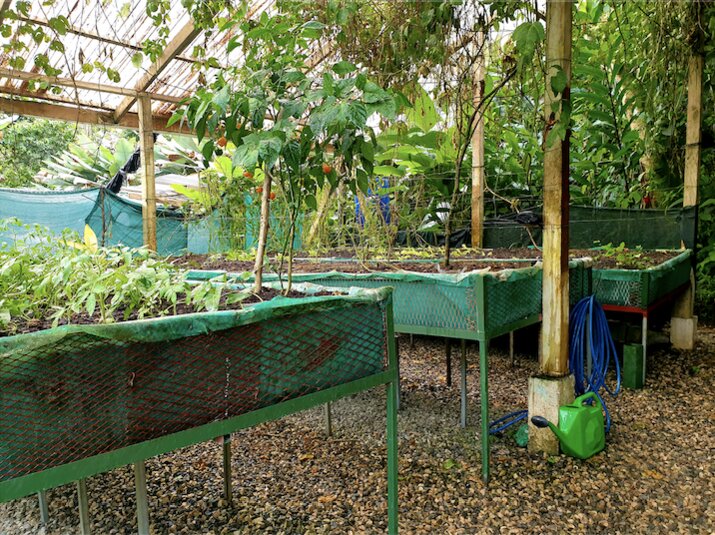
We grow cucumbers, tomatoes, malabar spinach, chili, Bok Choy, mustard, and many herbs here which brings us a big step closer to our goal of self-sufficiency.

Studio
Studio
Alexander's house is a minimalistic open space, double-functioning as home and painting studio.

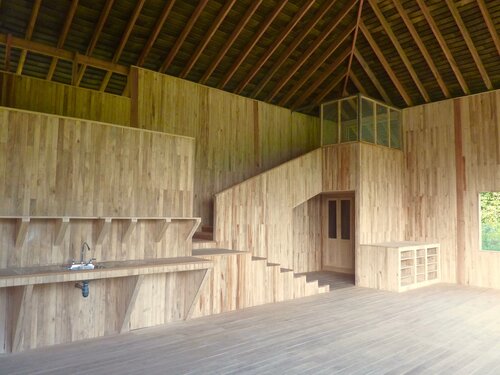

To learn more about our sustainable architecture, click here.

Bungalows
Bungalows
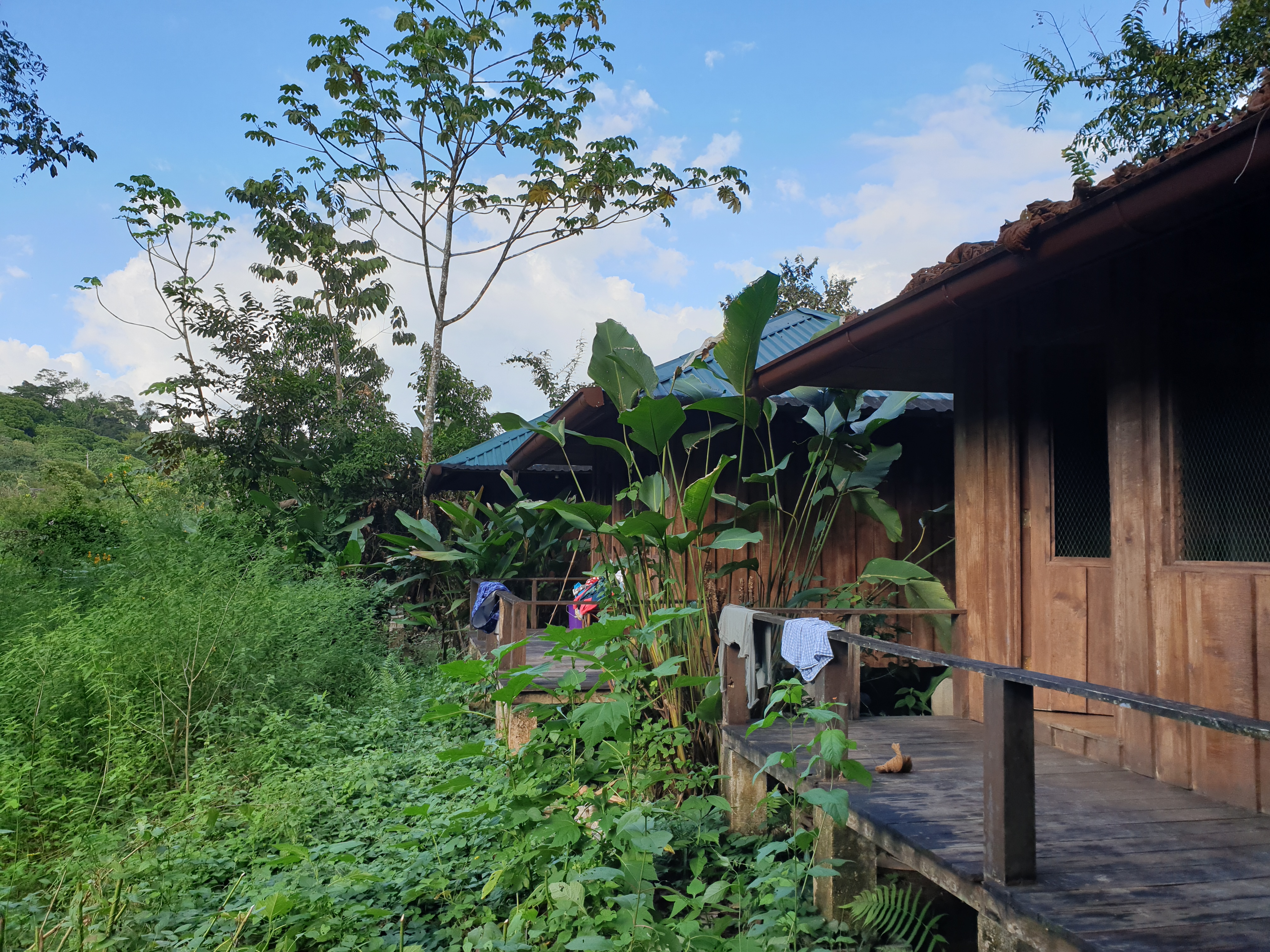
The three bungalows for volunteers ...

are simple, spacious and comfortable.

From the terraces, one has view over the bungalow pond which is now covered with water plants.
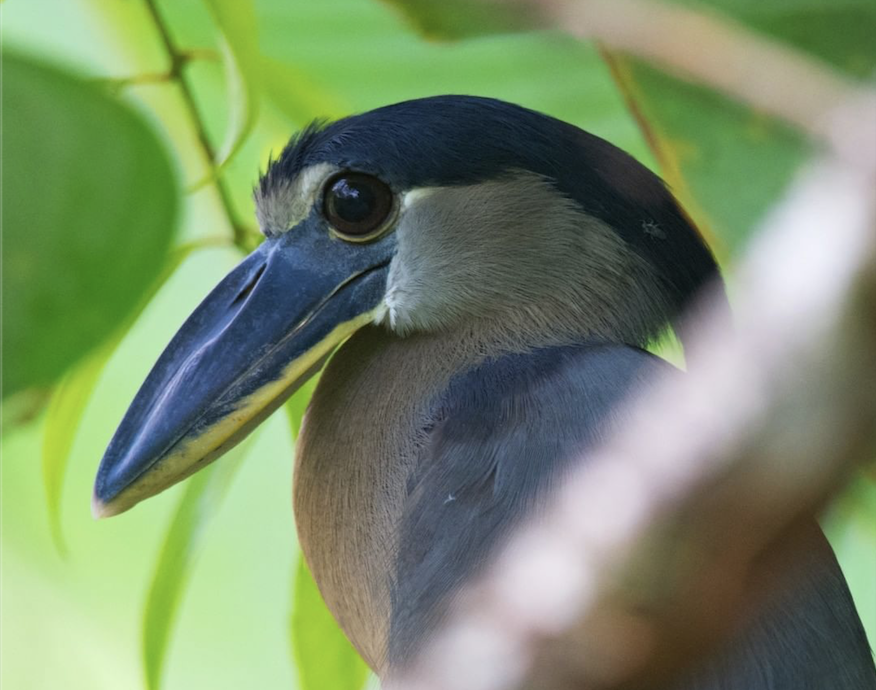
Since the boat-billed herons (Cochlearius cochlearius) arrived, which are raising their young, we left the pond undisturbed: animals in the Refugio always have priority.
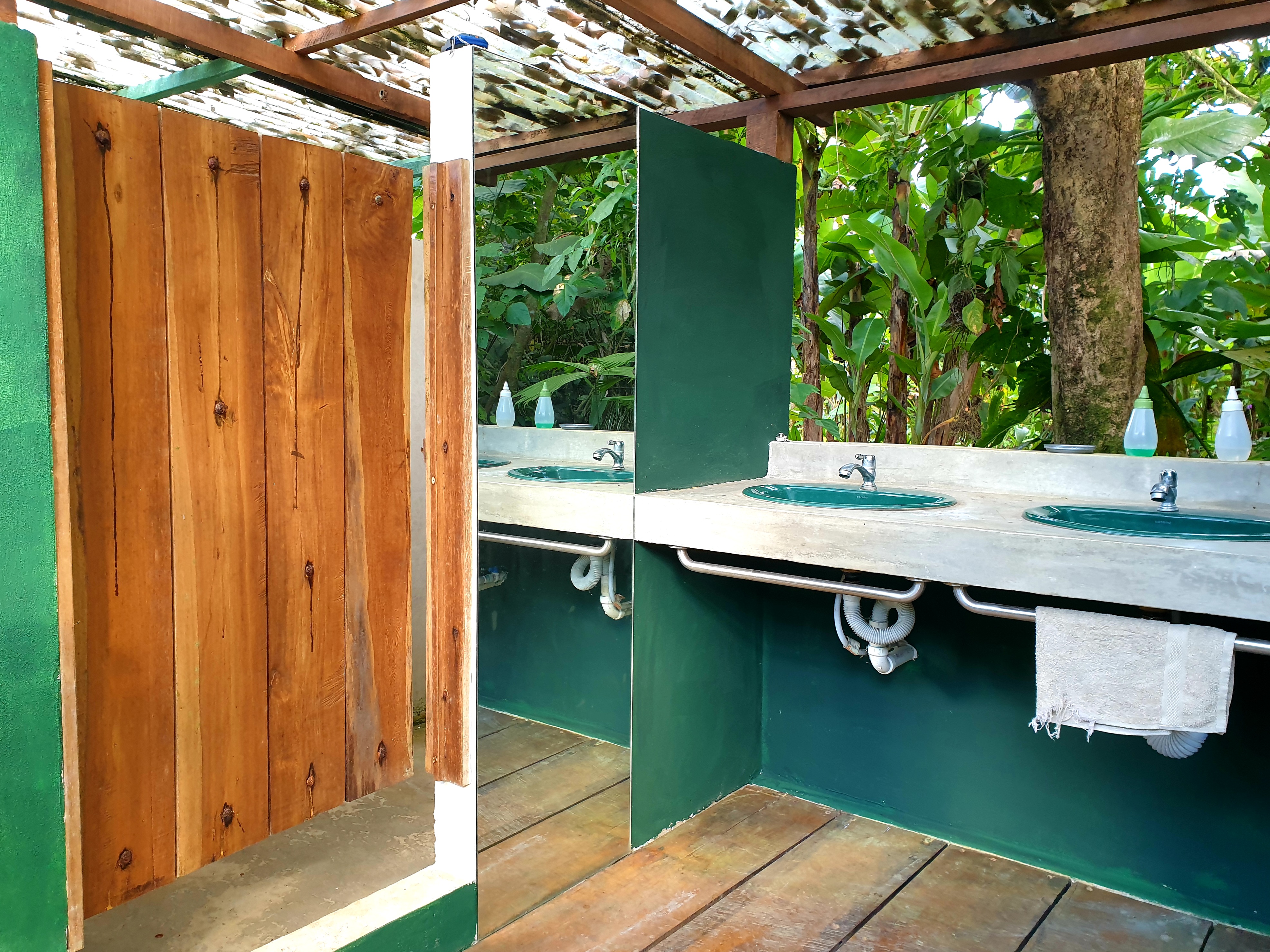
All bungalows share outdoor bathrooms ...

and composting toilets.
To learn more about our sustainable architecture, click here.

Guest house
Guest house
Our guest house is a spacious and open 50m² (540ft²) bungalow facing a calm pond, offering scenic views and maximum privacy.
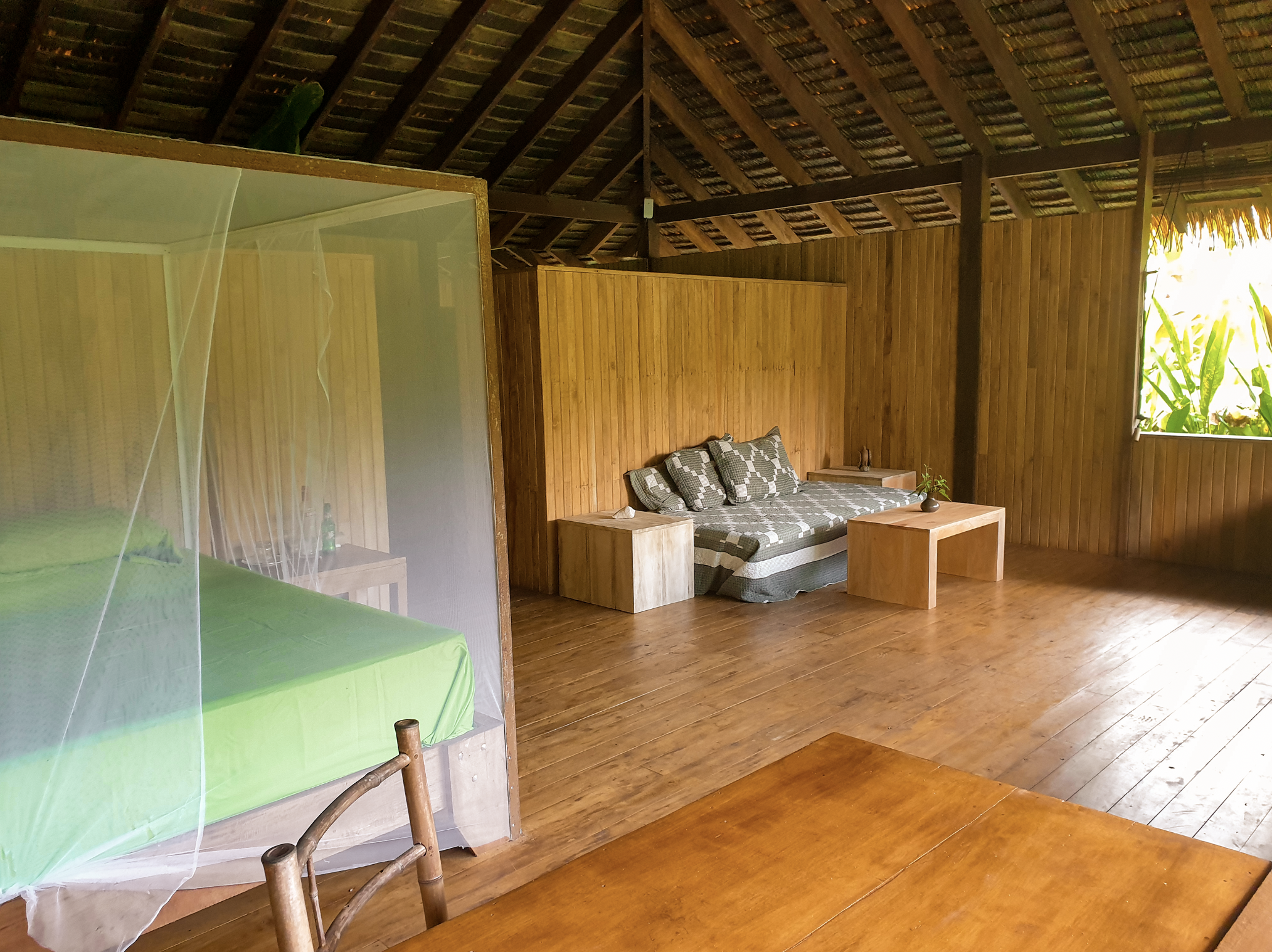
It features a king-size bed, an ensuite bathroom, a walk-in closet, ...
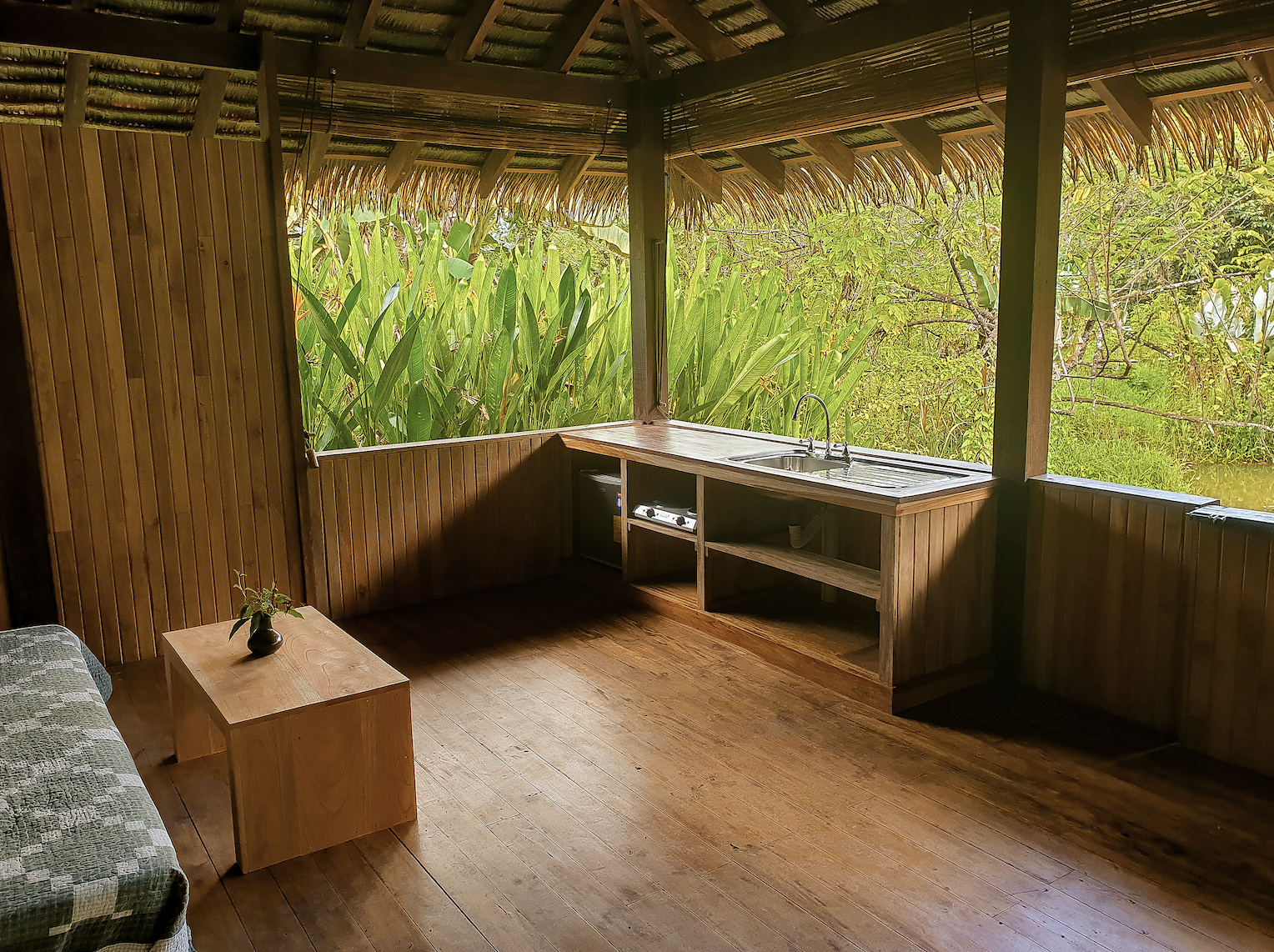
a kitchen, WiFi and electricity (but no electric light out of respect for the wildlife).
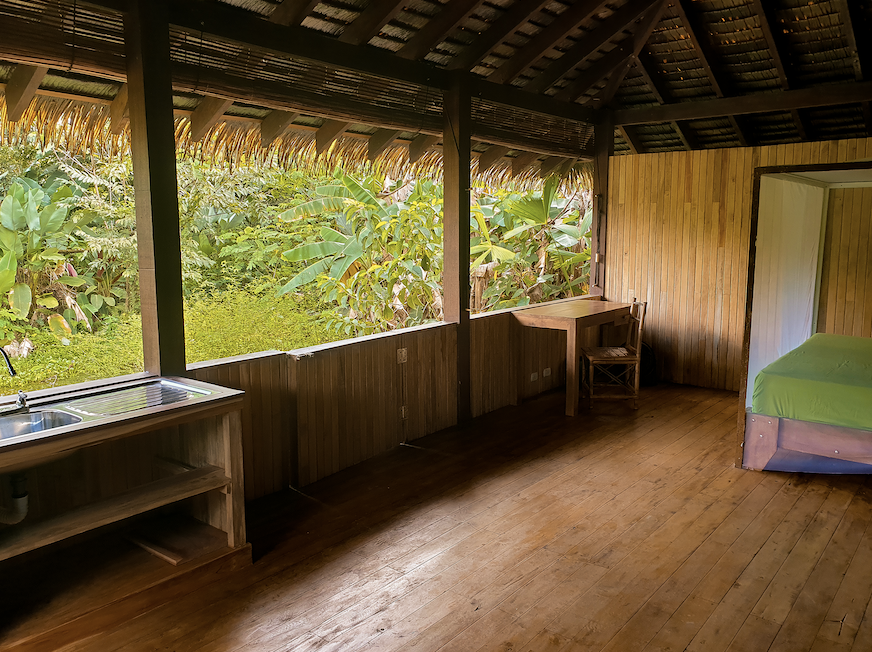
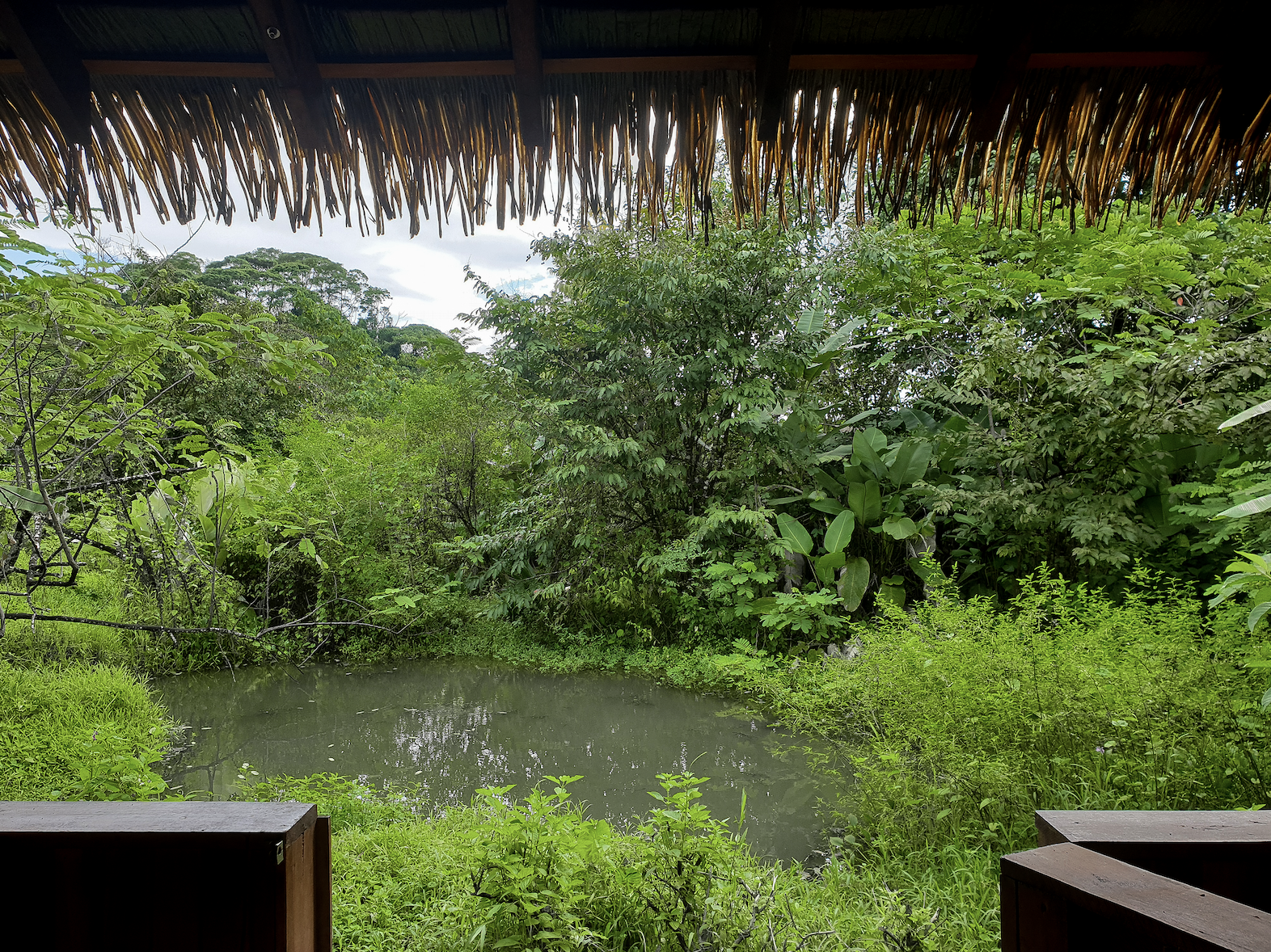
More information can be found here. To learn more about our sustainable architecture, click here.

Casa Grande
Casa Grande

The Casa Grande is an open, communal building, consisting of four octagons combined. It contains a living area, a kitchen, a dining area, an office, and a library with several thousands of books.

The living area, overlooking the big pond.

The kitchen, where cooking and washing dishes is a joy.

The dining area in the center, surrounded by the library.
To learn more about our sustainable architecture, click here.

Light pollution
Light pollution
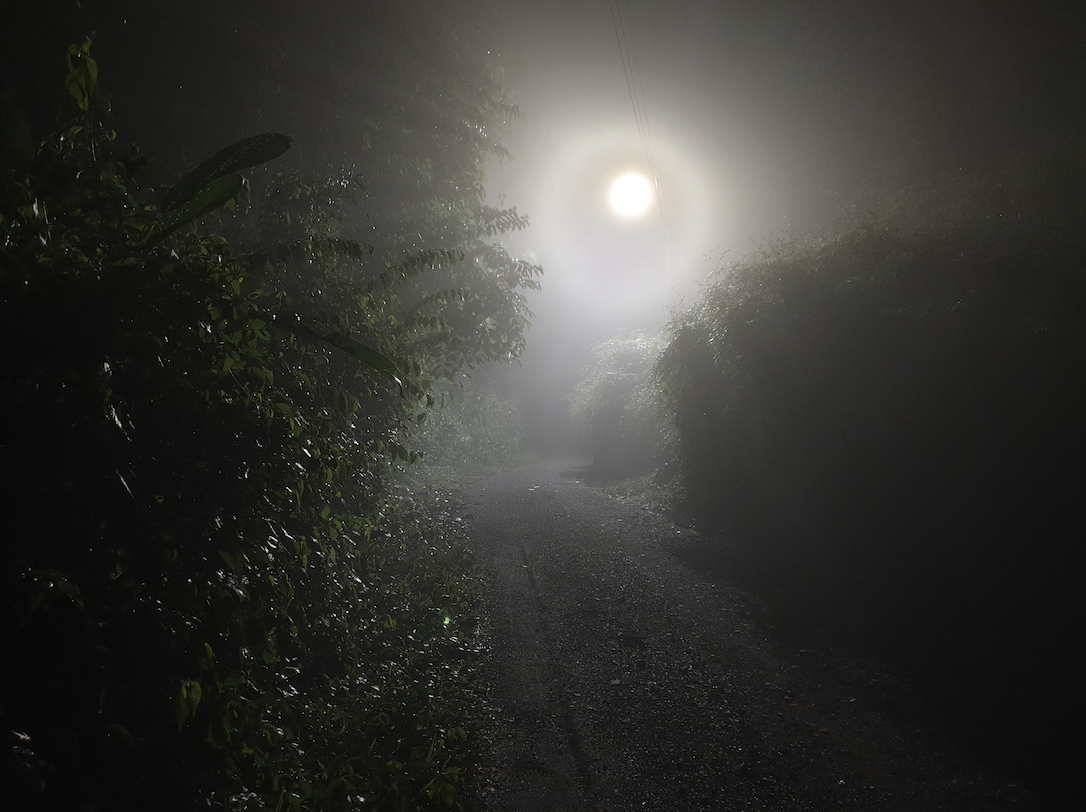
Light, especially in pristine areas, interrupts whole ecosystems, badly affects all sorts of night creatures and even plants. Besides big cats, owls, fireflies and many other charismatic animals, the heaviest brunt is surely taken by insects, with the majority of them not even discovered yet. As we recognized the damage light can do, especially next to a national park, we decided to abstain from artificial lighting and artificial noise.
To our surprise, the switch to living without electric lights was much easier than we expected. Organized use of sunlight hours and a small change in sleeping habits was all it needed. As a result, we found living with the rythm of nature energizing, stress-relieving and actually very comfortable. And the biggest gift: we are surrounded by all the animals that otherwise would not be around ...
